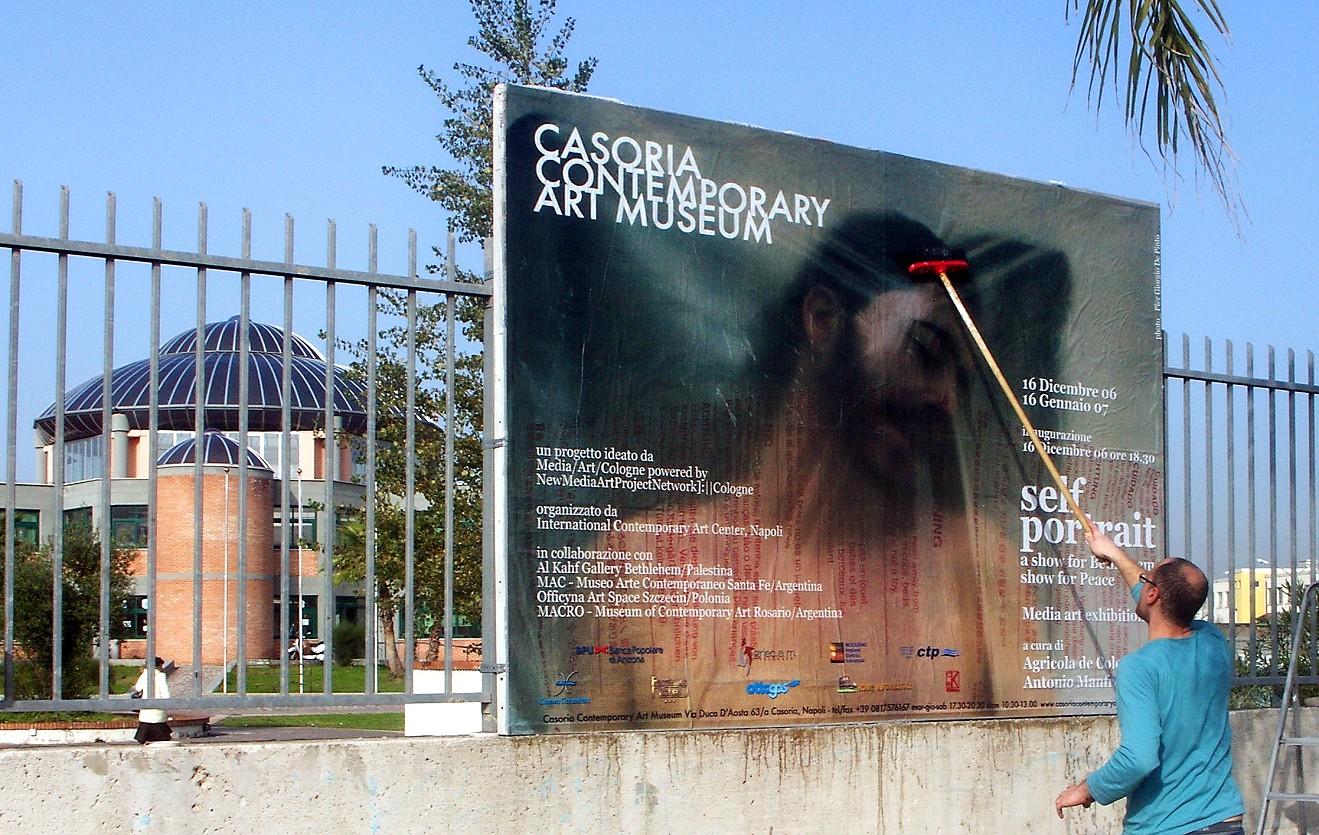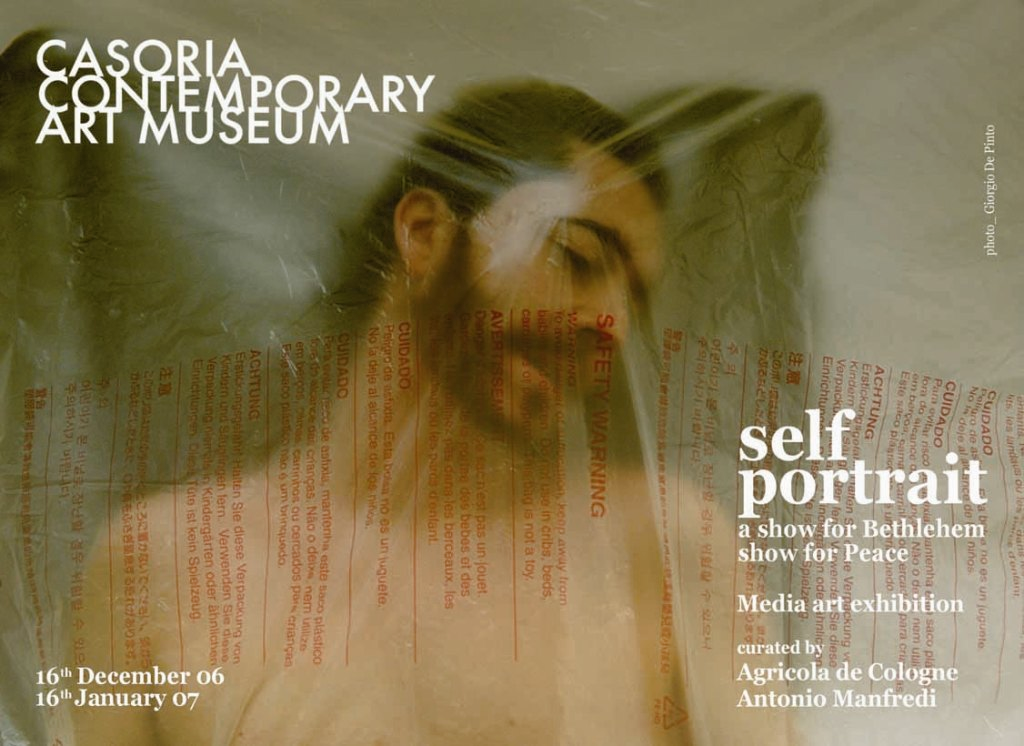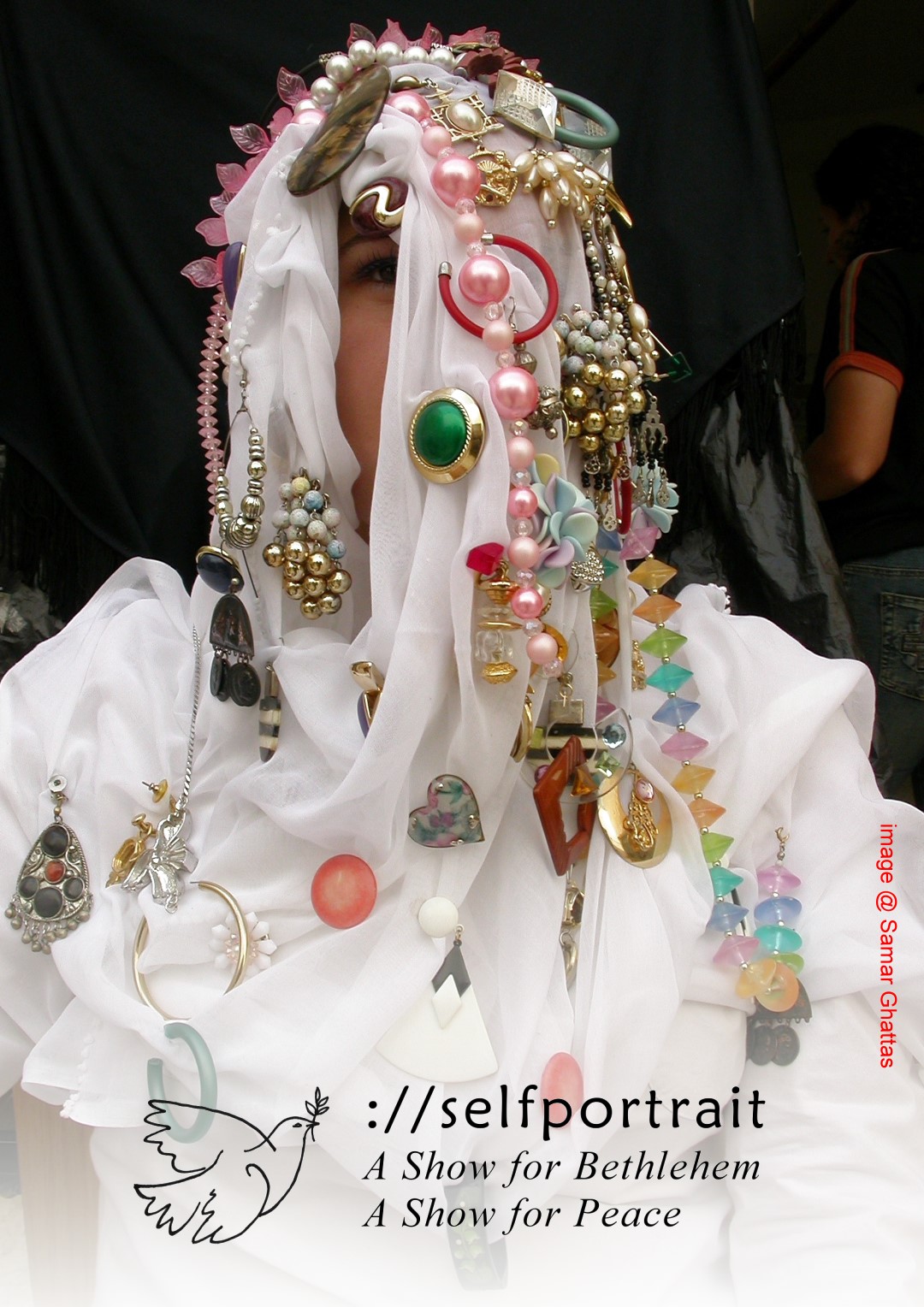

://selfportrait – a show for Bethlehem
is the second media art exhibition project in Bethlehem/Palestine – initiated and curated by Agricola de Cologne, independent curator and director of
The New Museum of Networked Art.
This media art exhibition was initiated and organised on occasion and in the framework of 10th anniversary of the twincityship of the municipalities of Cologne/Germany & Bethlehem/Palestine to be shown first in Bethlehem at Al Kahf Gallery at Bethlehem International Center – 06-30 July 2006.
artvideoKOELN is proud to collaborate afterwards with Casoria Contemporary Art Museum Naples/Italy and the show to be inaugurated on 16 December 2006 as a message of peace to the world on occasion of Christmas, the birth of Jesus Christ in Bethlehem, whereby the clone to be exhibitited wil become a part of the permanent museum collection.
Through its relevance in three world religions, Bethlehem was during more than 2000 years a symbol for peace also beyond, but since some time Bethlehem and the entire Holy Land on the Westbank
is vanishing behind a huge wall as the result of a conflict in Middle East which is threatening world peace since many years.
By being present personally in Palestine after 2005 for the second time in 2006, Agriccola de Cologne and the incorporated artists are showing face through their selfportraits, via the show they artists overcome symbolically this wall which is separating Israel and Palestine, and become messengers of peace this way.
The show does not only transport the message of solidarity, but also the idea of a free and independent culture without borders, the use of New Media technology represents further a symbol for a new era for solving conflicts via communication. So, the exhibition becomes a contribution to peace on earth, there are conflicts in many parts on the globe, there virtual and physical walls everywhere to be overcome. Living in peace is a human right forming the basis for othzer human rights.
://selfportrait – a show for Bethlehem
incorporates about 350 artists and following aspects of New Media presented in physical space – digital prints to be installed in space or on walls, digital video via projections and installations, multi-media based on different technologies and sonic art via display on computer installation, and not to be forgotten, the artists statements via projection and display on monitors which give an idea about the visions of contemporary artists.
Project site
http://self.engad.org/
contact the curator
Wilfried Agricola de Cologne
artvideoKOELN international
Mauritiussteinweg 64
D – 50676 Cologne
artvideokoeln (at) gmail.com
Project development & design, concept & organisation
copyright © 2006. All rights reserved
All artists works – copyright © by the artists or owners.
–>
Media/Art/Cologne
in cooperation with
VideoChannel – http://videochannel.newmediafest.org
SoundLAB – http://soundlab.newmediafest.org
&
Bethlehem International Center/Palestine
Casoria Contemporary art Museum Naples/Italy
Officyna Art Space Szczecin/Poland
MAC – Museum of Contemporary Art Santa Fe/Argentina
MACRO – Museum of Contemporary Art Rosario/Argentina
The exhibition was initiated in the framework of the twincityship
Cologne-Bethlehem in cooperation with the municipalities of
Cologne & Bethlehem, and the
Society TwinCityship Cologne/Bethlehem

After the show in Bethlehem (July 2006) the exhibition collection has been modified and extended. Especiall the inclusion of “memoryscapes” a collection of soundart powered by SoundLAB underlines the variety of media and artists, which are symbol for the variety of a worldwide culture without boundaries.
Currently about 360 artists from 30 countries are participating. Please find below the artists names linked with their biography. For viewing the artworks please use the link
.
digital print (51)
on DVD
digtal video (42)
On CD-ROM
multi-media (18)
soundart (16)
More Soundart
memoryscapes (140)
powered by SoundLAB
Curatorial contribution from Chile by Rainer Krause (Santiago de Chile)
Featuring these Chilenian artists,
Luis Barrie, Claudio Fernandez Sini, Foro de Escritores (FDE), Ensamble Majamama, Radio Ruido, Mario Soro, Andres Torres, Pintor Z
Artists curated by Melody Parker-Carter
Martin Aaserud (Norway) N.B Aldrich,. & Zach Poff, (USA) Martin Stig Andersen, (Denmark) Andreja Andric (Serbia/Italy), Isabel Arevalo (Spain) Mauro Arrighi (Italy) audio_z (Tautvydas Bajarkevicius) (Lithuania) Sara Ayers (USA), Back Ted N-Ted aka Ryan Breen (USA) Jim Barrett aka NaDa BaBa (Sweden) Leandro Barzabal (Argentina) Becoming Animal, Michael Beijer (Netherlands) Kari Besharse (USA) Rich Bitting (USA) Chris Bors (USA) Donald Bousted (UK), BrailleBones (A.Desjardins) (France) Jackie Bruce (Germany) Mira Burt-Wintonick (Canada) Bibi Calderaro (USA), Callanan, Martin John (UK) Chelsea Cargill (UK) Bronwen Casson (Ireland) Gregory Chatonsky (France), David Chesworth / Sonja Leber (USA) Kyong Mee Choi (S.Korea) Catherine Clover (UK) William Fowler Collins (USA), Herve Constant (UK) Luis Coronado (Guatemala) Jessica Curry (USA) Audhild Dahlstrom (Denmark), Markus Decker (Austria) Paul Devens (Belgium) Linda Rae Dornan (USA) Matt Dotson (USA) Dorsey Dunn USA), Jared Dunne /Meloday (USA) Aniruddha Dutta (India) ELICHEINFUNZIONE – Davide Fabbri (Italy) Heloisa Escudero (Brazil/USA), Fernandez Fernand – Michalak Thomas (UK/France) Flow Ir In (USA) Jason Freeman (USA) Federico Fronterrè (Italy), Satoshi FUKUSHIMA (Japan) Lukas Fütterer (Germany) Gintas K (Lithuania) Matthew Giraudeau (UK), Unclejim – Goard, David & Robinson, Rob (UK) Josh Goldman (USA) Suguru Goto (Japan) Scott F.Hall (USA), Dawn Salvia (USA) Francis Heery USA) Volker Hennes (Germany) PAULO HENRIQUE (Brazil) Ronald J.Herrema (UK), Alex Hetherington (UK) Jeremy Hight (USA) John Maxwell Hobbs (USA) Olaf Hochherz (Germany), G.H.Hovagimyan, & Peter Sinclair (USA) hp stonji (Hans Platzgumer &Jens Döring) (Austria) Le Tuan Hung (Vietnam), Yuicho Ito (Japan) Margaret Jameson aka tinydiva (USA) Paul Jamrozy- Satellitic USA) Neil Kaczor (UK) Mikhail Karikis (UK), Juan Kasari aka 80juan80 (Finland ) David Kasdorf (USA) Kazuo Kawasumi (Japan) James Kelly (USA), Alexander Kharkovsky (Russia) Meri von KleinSmid (USA) Panayiotis A. KOKORAS (Greece) Phivos-Angelos Kollias (Greece), Savvy Krajcek (USA) Caroline de Lannoy (UK) Al Larsen (USA) Gregory Lasserre, & Anais met den Ancxt (France), Dario Lazzaretto (Italy) Le Lavatrici Rosse (Italy) Alan Lechusza aka ARCANUM (USA) Sara Lenzi (Italy), Les Riches Douaniers (France) Tsui-Lun Liu (Taiwan) Stephanie Loveless (USA) Emily Lutzker (USA) Raphael Lyon (USA), Matthew MacKisack, USA) Luigi Mastandrea (Italy) Mike McFerron (USA) Mental Youth aka Robert Kroos (USA), Wolfgang Peter Menzel (Sweden) Jenni Meredith (UK) Jeff Morris (USA) Rie Nakajima (Japan) Ailis Ni Riain (Ireland), Sean O’Neill (USA) Mattyo Ostrowski (USA) Stefano Pasquini (Italy) Stefanos Pavlakis (UK) Debra Petrovich (Australia), Michael Pounds (USA) Peter Prautzsch (Germany) Puccini Marco (OTO) + virgilio VJ (Italy) RijN – Walter van Rijn (Netherlands), Neil Rose (USA) Paula Roush (UK) Rovar17 (Hungary) Robert Rudolf (Slowakia) Grit Ruhland (Germany), Khaled Sabsabi (Australia) Luz María Sánchez (Mexico) Janek Schaefer (UK) Debashis Sinha (Canada) Kenji Siratori (Japan), SonicTrain (Koji Kawai, Rui Ogawa, and Kenya Kawaguchi) (Japan) Malte Steiner (Germany) Peter V.Swendsen (USA), tarofonika aka Rick Foot (USA) Jouni Tauriainen (Finland) Jacqueline Then (Singapore) JEFF THOMPSON (USA), Eldad Tsabary (USA) Tetsuya Umeda (Japan) Peter Wadham/ Susannah Brown (USA) Shirley Wegner (USA) Simon Whetham (UK) Duncan Whitley (USA) Jake Whittaker (UK) Shane Wilson aka Deciduous (USA)
My Mission – 100 artists’ statements
Daniel Young (USA)
Mr. Robert Montini (USA)
Robin Miller (USA)
Richard Ellis (USA)
David Crawford (USA)
Kristin Calabrese (USA)
Michael Crane (USA)
Lisa Ndejuru (USA)
Doren Garcia (USA)
Seth Thomson (USA)
Alan Sondheim (USA)
C.D. Beltran (USA)
Luckywings (USA)
Lynne Taetzsch (USA)
John Kannenberg (USA)
Scott Becker (USA)
Lois Klassen (USA)
Nathan James (USA)
Jubal Brown (USA)
Natasha Radell (USA)
Jeremy Newman (USA)
Dizzy (USA)
Sarah Browne (USA)
Pace F . Parado (USA)
Mark Wolfe (USA)
Carole Loefler (USA)
Dr. Hugo (Belgium)
Rene Joseph (Belgium)
Eric van Hove (Belgium)
Eva Lewarne (Canada)
Gita Hashemi (Iran/Canada)
Barry Smilie (Canada)
Wendy Lu (Canada)
Graham Thompson (Canada)
Julie Andreyev (Canada)
Ijosé Benin (Canada)
Cyril Duneau (Canada)
Garnet Abrahams (Canada)
Blair Butterfield (UK)
Caterine Daly (UK)
Richard Osborn (UK)
Brian Routh (UK)
Veronica C. Wilkinson UK)
Davon Hlongwane UK)
Luna Nera (UK)
Nigel Petherick (UK)
Maggie Montgomery (UK)
Corina Pia (UK)
Shaukat Khan (UK)
Ann Tracy (UK)
Heather J. Tait (UK)
X Rokeby (UK)
Luigia Cardarelli (Italy)
Carla Della Beffa (Italy)
Pino Boresta (Italy)
Alberto Frigo (Italy)
Boel Olsson (Sweden)
Michael Haskett (Sweden)
Peter Svedberg (Sweden)
Eric B. Petersen (Sweden)
Ksenija Kovcevic (Serbia)
GORZO (Serbia)
Zon Sakai (Serbia)
Cecilia Lueza (Italy)
Aynil (Italy)
Domenico Olivero (Italy)
Ida Dominici (Italy)
Roberto Echen (Argentina)
Leandro Katz (Argentina)
Anahi Caceres (Argentina)
Francisco Vidal (Argentina)
Stella Maris Angel Villegas (Argentina)
Cendres Lavy (France)
Xavier Malbreil (France)
Yavier Pehuet (France)
Aikaterini Gregisian (France)
Antonio Alvarado (Spain)
Alvaro Ardévol (Spain)
Klaus W. Eisenlohr (Germany)
Marcello Mercado (Germany)
Sandra Becker (Germany)
Volker Behrend Peters (Germany)
Joern Ebner (UK/Germany)
RAnders (Germany)
Jd.Vd’Aragon Aranita (Hong Kong)
Lee Welch (Ireland)
Harriet Jamesson Pellizari (Austria)
Teo Spiller (Slovenia)
Fabian Giles (Mexico)
mm
Anthony Leland (New Zealand)
gintas K (Lithuania)
Sergeij Jakovlev (Russia)
Igor Ulanosvsky (Israel)
Cezar Lazarescu (Romania)
Clemente Padin (Uruguay)
Andres Yepes (Venezuela)
Miss C. Johnson (South Africa)
Nitin Shroff (Seychelles)
Solveig Kjok (Norway)
Ricardo Mirada Zuniga (Nicaragua/USA)
#
Temporary participation
Gabi Bila (Germany)
GeheimRat (Germany
Peter Wolf (Germany)
Mireille Astore (Lebanon/Australia)

The exhibition
://selfportrait – a Show for Bethlehem – a Show for Peace
7-30 July 2006
Bethlehem (Palestine) Al Kahf Art Gallery @ International Center Bethlehem
20 October – 20 November
Szczecin (Poland) – Officyna Art Space
10 December 2006 – 28 January 2007
Santa Fe (Argentina) – MAC – Museo Arte Contemporaneo
Universidad Nacional del Litoral
16 December 2006 – 1 February 2007
Casoria/Naples (Italy) – Contemporary Art Museum
2 February – 31 March 2007
Rosario (Argentina) – MACRO – Museo Arte Contemporaneo
Concept & realisation – supervisor & chief curator
@ 2006-2007 by Wilfried Agricola de Cologne
Coordinators & co-curators
Cologne (Germany) –> Wilfried Agricola de Cologne
Media/Art/Cologne – now artvideoKOELN international
Bethlehem (Palestine) –> Faten Nasdas Annadwa, Inger johannson
coordinators @ Annadwa – International Center Bethlehem
Szczecin (Poland) – Antoni Karwowski
curator @ Offycina – space of art
Naples (Italy) –> Antonio Manfredi
director @ Casoria Contemporary Art Museum
Santa Fe (Argentina) –> Stella Arber
director @ Santa Fe University Contemporary Art Museum
Rosario (Argentina) –> Roberto Echen
director @ MACRO – Rosario Contemporary Art Museum
All artworks included in the exhibition © by the artists or owners
All additional texts, images and media components @ by the authors or owners.
Venues
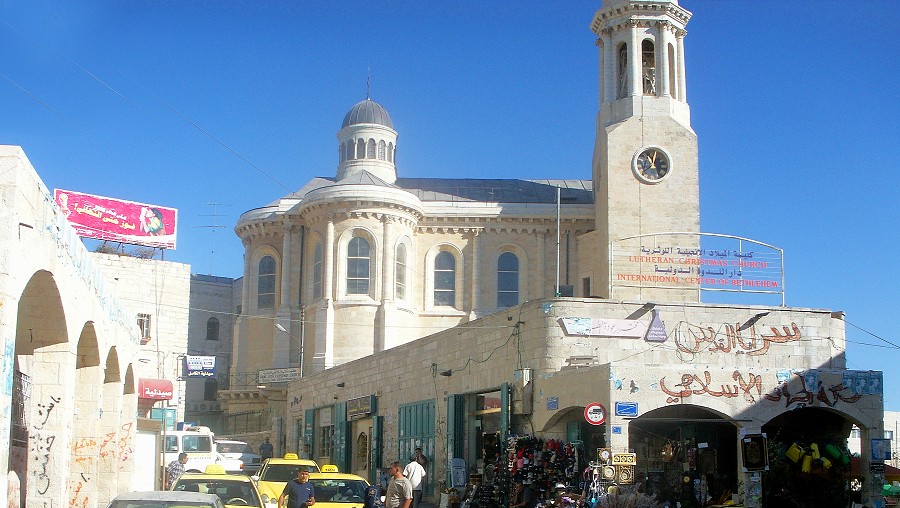
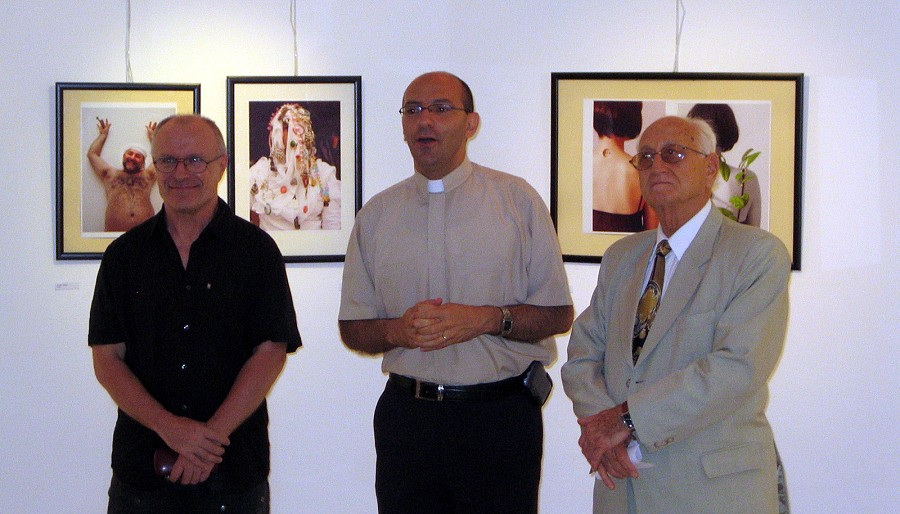
On 6 July 2006, 19h
the exhibition was opened at Al Kahf Art Gallery at Bethlehem International Center
by the Mayor of the City of Bethlehem Mr. Dr. Bartaseh,
Mr. Mitri Raheb, the head of the Lutheran Church and Bethlehem International Center, and
Agricola de Cologne, organiser and curator of ://selfportrait – a show for Bethlehem.
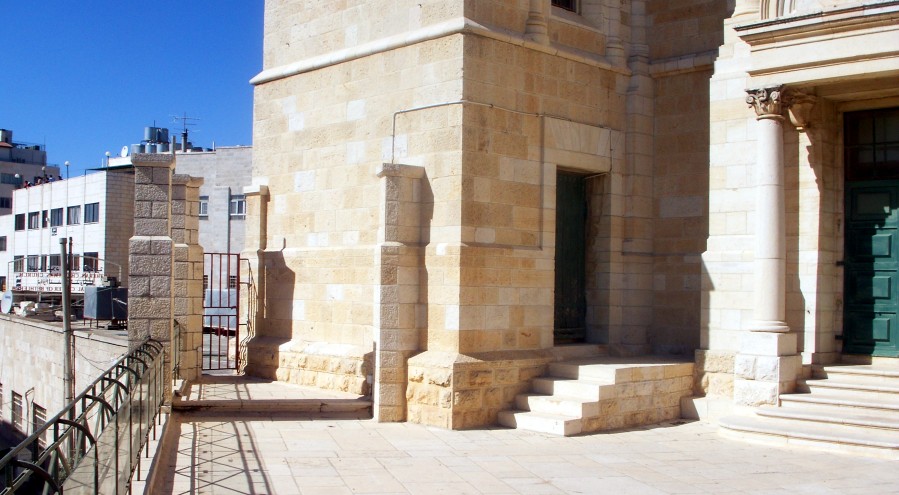
Between 7 and 30 July 2006,
://selfportrait – a show for Bethlehem – was installed at Al Kahf Art Gallery at Bethlehem International Centre – here is a short review & documentation —>
Bethlehem, and Palestine in general, represent a difficult problem, as both have a kind of status of no rights and no back-up area. It is a prison for those who have to live there and call it the home country, and a prison to those who want to visit it: occupied by Israel in the 6 days war, but not accessable for any Israeli, and Palestinians may only leave this completed walled in area by using a special permission which most of them never get.
Walling in the Palestinian residencial areas together with all the people who are living there is seperating them from each other causing a disastrous psychological effect.
By visiting Bethlehem and standing in front of the 9 meter high wall, one has to be aware of this humanitarian disaster. Differently from the current conflict with Lebanon, the conflict in Palestine does not seem to be worth any headline, it never really was – yes the Palestinian have no lobby, otherwise the wall would have never been built, at all.
One has to understand not only the facts, but also the psychological condition, and then it will become clear, that people who are condemned to live in a prison loose the activity for life, they become depressed, demotivated and resignated.
The purpose of living is just to survive the very day, and art which has a different meaning in Arabic countries in general, has the status of a kind of luxury which nobody can afford materially and emotionally.
The message many foreigners receive as a response is “We do not need you”, nobody would tell you that bluntly into your face, however.
One can get aware of this situation, however, just by being there, otherwise nobody would dare to invest a lot of energy, time and money for showing collective solidarity when this engagement is not recognized by those the solidarity is addressed to.
These were the conditions under which I entered the checkpoint of Bethlehem this year, and they were unfortunate, indeed, not only due to the escalating conflict in Gaza and Lebanon.
This negative spirit accompanied me during the entire visit. Anyway, finally shortly before the opening ceremony was taking place, the installation of the exhibition was complete, and it was professionally done the way it was possible under the given circumstances.
The offical opening took place on 6 July, 19h under the participation of the Mayor of the City of Bethlehem, Dr. Bartaseh, the head of Bethlehem International center, Mitri Raheb, who is also the head of the Lutheran church in Bethlehem, and my person Agricola de Cologne, the curator and organiser of the show. Dr. Bartaseh, not so accustomed to use a computer for artistic purposes, seemed to be very excited to surf on one of the installed computers through online exhibition interface. Yes, this was one of the few postive aspects, i.e. the needed technical equipment worked perfectly.
The idea, that through their selfportraits the artist were personally present at Bethlehem and showed their solidarity with Palestinians living behind the wall found much interest among the visitors, also because in Arabic countries the representation of the human image is actually not allowed, or at least people are not accustomed to deal with that.
However, it was obvious, that the majority of visitors were foreigners living in Bethlehem, just only few Palestinians and no Muslim Palestinians at all, although meanwhile the Muslims represent also in Bethlehem the majority of the population. I found this quite frustrating that those people the exhibition actually was adressed to were not present or visible, but slowly I began to understand, what I described before, it is simply not the time for art currently, and Bethlehem is beyond all also not a city of art, at all.
I would lie if I would make the resume, I would be happy, but it is obviously really like that, that it was already a big successs that the exhibition took place at all, while other cultural events planned in Bethlehem and Palestine had been cancelled due to the recent political conflict.
I do not want to waste the reader’s time and start complaining about certain details, but I would like to state anyway, that each activity which give the local people the feeling they are not forgotten, makes much sense, even if the organiser, in this case me, was quite frustrated and is currently rather tending to continue his cultural engagement in Middle East not any longer.
Personally, I think more cultural activists should become active in Palestine, not just by importing art, like it happens mostly currently, but by giving motivation and perspectives as a cultural strategy.
Unfortunately, not many Western countries support such cultural activities, and if at all, then completely insufficiently.
About the location & exhibition
Bethlehem International Center is a kind of “paradise” within an otherwise nearly hostile environment, a historical buidling complex reconstructed by a Finnish architect for future related purposes, a Christian run institution which is the home of a couple of National Palestine institutions, like the National Music conservatory, several craft and art related workshops, a theater and conference center, the Lutheran Christmas Church, a good restaurant and also the Al Kahf Art Gallery.
Al Kahf means “cave”, in this way the art gallery is also situated underground and very original, including two caves orginating from more than 2000 years ago. The name of the gallery is also a good symbol for the survival of art in Bethlehem.
For exhibitions, however just two spaces are used, the main gallery and the former “cisterne”, the third space, a large cave, however, is too humid for being used for most art exhibits.
The main space was presenting the digital prints, the computers (two were online and the third was displaying the multimedia works) and a video monitor was looping one part of the selfportrait videos. The second part of the videos was screened/projected in the little cave of the cistern, an intimate space, ideal for video projections.
Here are some images from the small dimensional, but anyway beautiful show–>
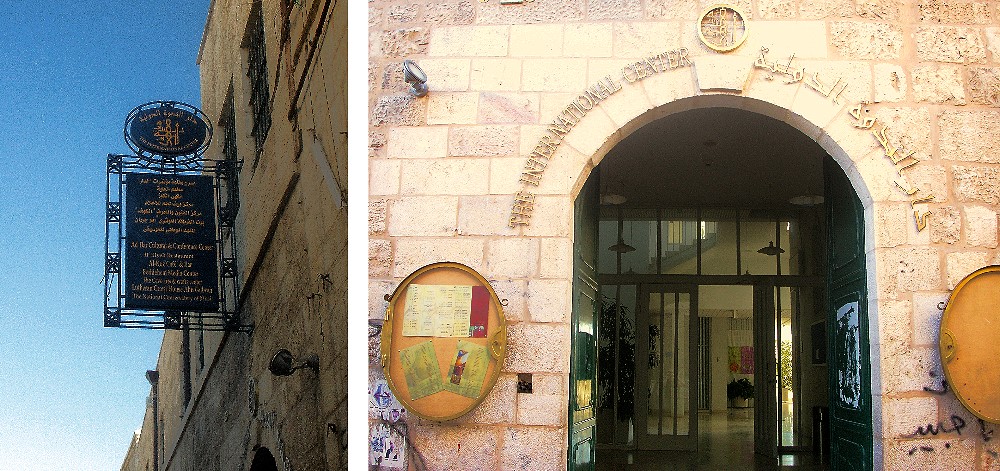
Bethlehem International Center entrance area
 Bethlehem International Center: backyard
Bethlehem International Center: backyard
 Bethlehem International Center: garden
Bethlehem International Center: garden
 stairs down to the gallery
stairs down to the gallery
 exhibition set up
exhibition set up
 main gallery
main gallery
 gallery view
gallery view
 exhibition installation
exhibition installation
 computer displaying the multi-media
computer displaying the multi-media
 video installation
video installation
 Gita Hashemi’s work & the video installation Lina Persson
Gita Hashemi’s work & the video installation Lina Persson
 online computers running the exhibition interface
online computers running the exhibition interface
 work by Larissa Sansour (Palestina artist)
work by Larissa Sansour (Palestina artist)
 Faten Nastas (ICB art coordinator and artist) and her exhibited work
Faten Nastas (ICB art coordinator and artist) and her exhibited work
 Samar Ghattas, Agricola de Cologne & Faten Nastas
Samar Ghattas, Agricola de Cologne & Faten Nastas
 Samar Ghattas (artist from Bethlehem) and her work
Samar Ghattas (artist from Bethlehem) and her work
 exhibition installation
exhibition installation
 the big cave
the big cave
 the cisterne – space for video projection
the cisterne – space for video projection
 Bethlehem International Center: the main stairs
Bethlehem International Center: the main stairs
 Bethlehem International Center: The restaurant
Bethlehem International Center: The restaurant
 the nativity church
the nativity church
 view over Bethlehem
view over Bethlehem
 view from Bethlehem to Jerusalem
view from Bethlehem to Jerusalem
 Bethlehem – tree of hope
Bethlehem – tree of hope
 the wall at AIDA refugee camp
the wall at AIDA refugee camp
 the wall close to the checkpoint
the wall close to the checkpoint
the opening on 6 July 2006
(images courtesy of Bethlehem International Center)
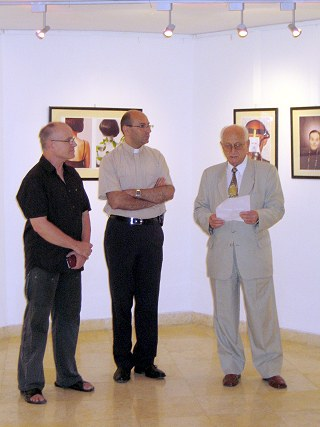 The Mayor of Bethlehem, Dr. Bartaseh (right),
The Mayor of Bethlehem, Dr. Bartaseh (right),
Mitri Raheb, head of Bethlehem International Center (center) & Agricola de Cologne (left)
 Dr. Bartaseh, Mayor of Bethlehem (right), Mitri Raheb, head of ICB (center) & Agricola de Cologne (left)
Dr. Bartaseh, Mayor of Bethlehem (right), Mitri Raheb, head of ICB (center) & Agricola de Cologne (left)
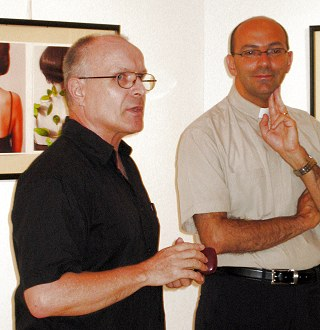 Mitri Raheb, head of ICB (right) and Agricola de Cologne (left)
Mitri Raheb, head of ICB (right) and Agricola de Cologne (left)
 audience at the opening
audience at the opening
 audience at the opening
audience at the opening
 audience at the opening
audience at the opening
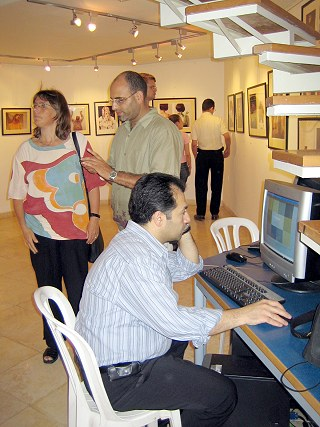 audience at the opening
audience at the opening
 installation at the cave
installation at the cave
 Dr. Bartaseh, Mayor of Bethlehem (left), Samar Ghattas, artist from Bethlehem and participant in the show (center) & Agricola de Cologne (right)
Dr. Bartaseh, Mayor of Bethlehem (left), Samar Ghattas, artist from Bethlehem and participant in the show (center) & Agricola de Cologne (right)
Bethlehem International Center
Al Kahf Art Gallery
7-30 July 2006
://selfportrait – a show for Bethlehem

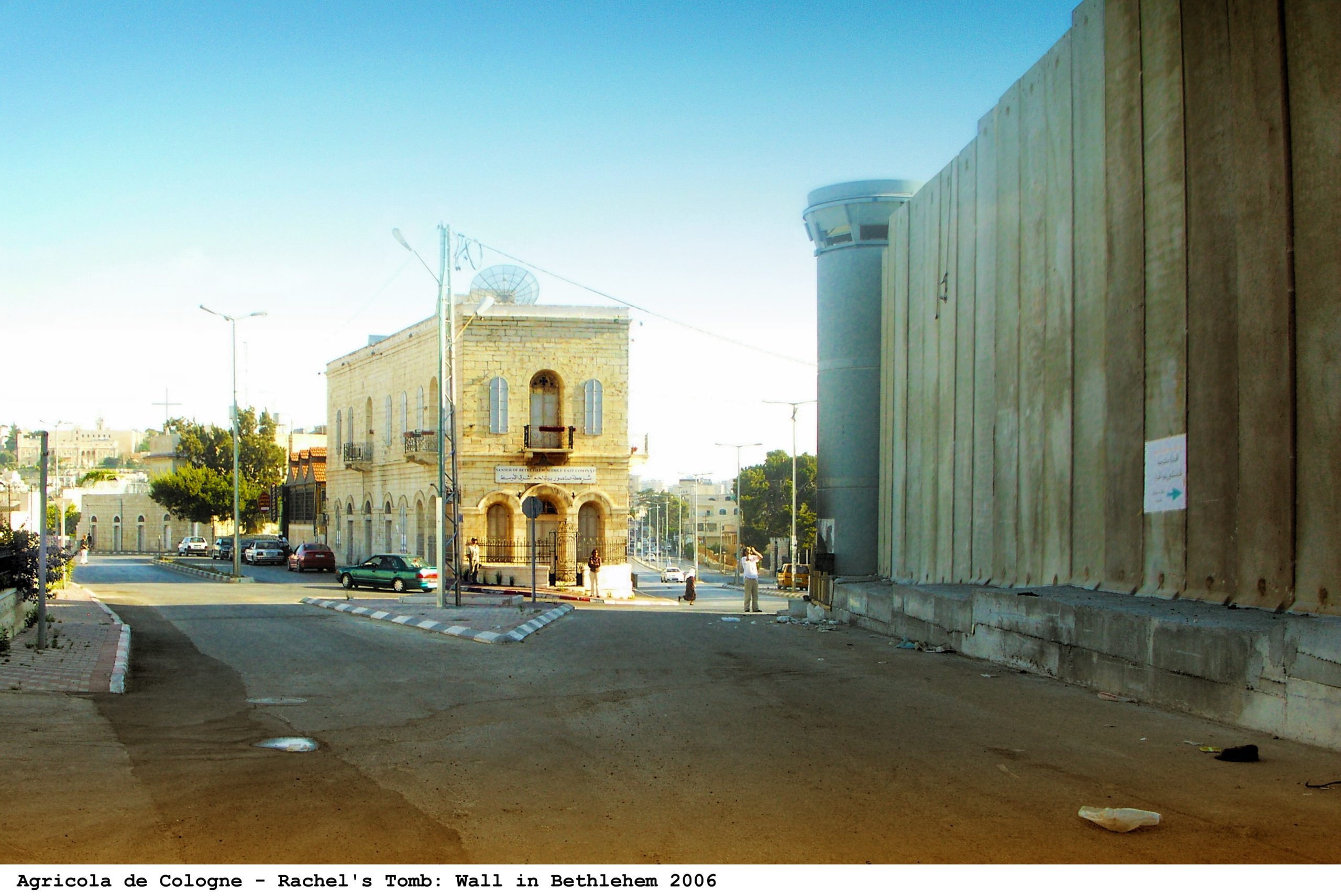
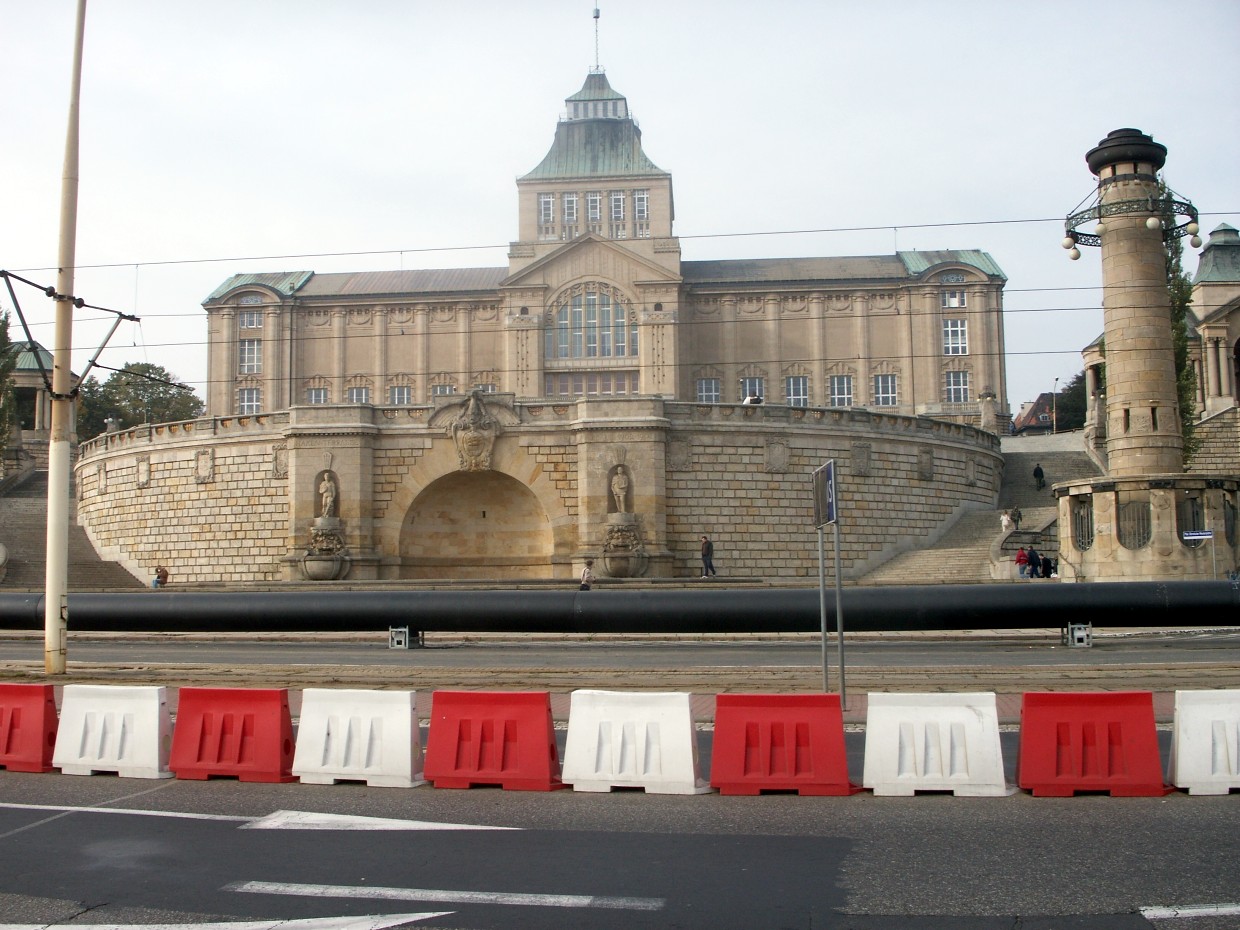
Nazional Museum Szczecin – locazion for screenings & performances
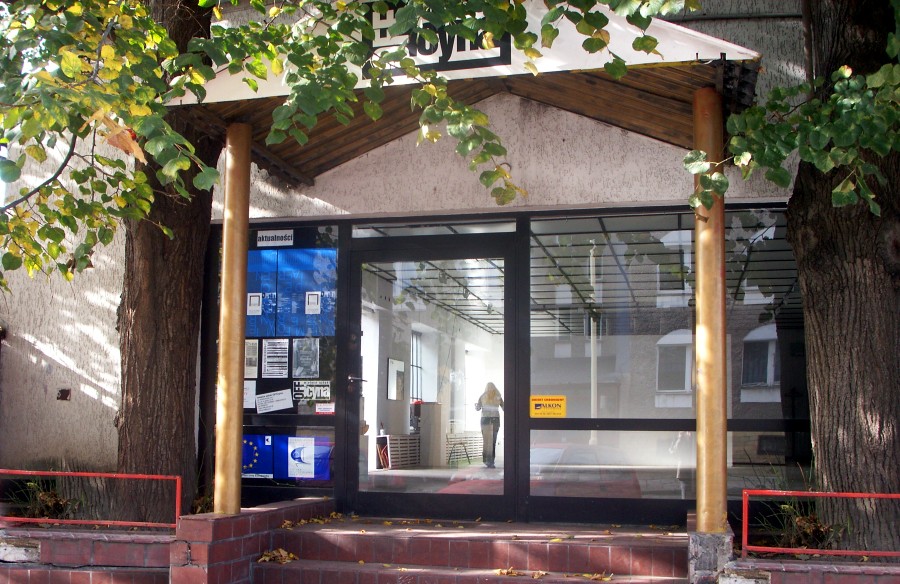
Offizyna Art Space – exhibition location
On Friday, 20 October 2006
://selfportrait – a show for Bethlehem – a show for Peace
was inaugurated at “the place of art – OFFICYNA“
as the starting event in the framework of
Performance and Intermedia Festival Szczecin/ Poland (20-22 October 2006)
Now the review and the image documentation are posted online —>
—>
From its historical and structural conditions, Szczecin was certainly a good choice for presenting our show for Peace. The city has a very changing history and was nearly completely destroyed in World War II. After the war there was not much to be reconstructed, and in this way the contemporary city is presenting itself strangely faceless without a real or historically grown city center. Everywhere are broken links visible and wounds which do not heal.
Since centuries German until the end of World War II in 1945, Szczecin became Polish afterwards. The city can certainly not be called a “place of art”, the few existing museums get lost in the strange architectural conglomerate.
Maybe this was the reason, why the founders of Officyna – a non profit art space, located somewhere decentrally in the suburbs of Szczecin – wanted to create a special “place of art”, i.e OFFICYNA, in order to give contemporary art expression a home and a space.
Nearly consequently, it is also Officyna which is organising divers festival events during a year, whereby a particular relevance got “Performance and Intermedia Festival”, an event which is curated by Antoni Karwowski, an internationally reknown Szczecin based performance and visual artist and organiser and independent curator of performance events since many years.
In 2005, I was curating for the 2005 festival edition a selection from VideoChannel for screenings during in the video section of the festival PI 5 Videofestival, and invited Antoni Karwowski for particiting in the show for Bethlehem. Later, he invited me to present the exhibition in Szczecin as the frist venue after Bethlehem.
Although the art space of OFFICYNA seemed to be a good place especially also for installing the selfportrait exhibition, during the installation phase these peope showed how they understood the term “professional”.
In contrary to what was agreed, the technical equipment and the needed exhibition components were not available or prepared in any way. Instead of starting the exhibition installation when I arrived at Szczecin, I was standing for two days in the icecold exhibition space waiting and waiting, and nobody knew what would be happening else than waiting, resulting that I caught a heavy cold, which was forced also by the icecold hotel room without any heating and partially also without electricity.
I do not want to go more in details in order to remain contructive, as in the end one minute before the vistors entered the gallery space for the opening precedure, the exhibition setup was finished. Inspite of all restrictions, I would say it was a very nice exhibition and a lot of feedback from the visitors confirmed by subjective impression.
The inauguration on 20. October was not standing for itself, but represented the start of PI Performance and Intermedia Festival, a festival organised at different locations.
The selfportrait exhibition represented the main part of the Intermedia section, besides some video installations which were set up in another exhibition space located in a separate building, but installed only during the festival days 20-22 October.
The next item after the two openings was the screening of videos as the part of PI Video Festival, whereby Agricola de Cologne, me, was the first who was starting the video screening. He presented a selection of Cologne OFF I – genderscapes, a selection of videos and short film dealing with gender issues and sexual identity.
Antoni Karwowski, the organiser and curator of the festival video section, was presenting his selection afterwards consisting of short videos with a duration of not more han 5 minutes.
The second day of the festival, 21 October, changed the festival location, the second part of the screenings and the extensive performance event took place at the National Museum of Szczecin, a volumious building originating from 19th century.
The evening started with the second screening curated by Agricola de Cologne–> Cologne OFF II – image vs music at the screening and event hall of the museum, followed by an unusual form of organising artists performances.
At midnight, the main performance section of the festival followed. The gigantic museum entrance hall was modified and used for presenting a dozen of performances simultaneously.
On one hand, the visitor has a wide choice between different performance works, but at the same time he got completely confused, and he did not know on which performance he should concentrate and prevent that he is missing anything. No chance, the visitor was really missing everything, if he is not concentrating from the beginning on one certain performance piece.
For me, who is no expert in the art of performance, I had my problems to value the single performance pieces as I tried to catch as many impressions from all the 12 peformances as possible.
Anyway, I think some of the participating artists should be mentioned individually.
Even I saw only short cuts, the excellence of some artists presentations could not be overviewed –> Antoni Karwowski (Poland), Valerian Maly (Switzerland), Andrzej Pawelczyk (Poland) and Chip for Peace (Poland). An artist who was really suffering from the unusual presentation form was the Berlin based CAP Grundheber, her performance located somewhere in the shadow between the huge columns of the museum architecture, and some other younger artists were also acting nearly without an audience. This is and was a pity.
On the 3rd day, 22 October, the festival was moving to another place – Swinouscije (German: Swinemünde) a place at the Baltic sea situated directly at the German/Polish boarder, where Andrzej Pawelczyk was organising a festival of art in action. Here the second screening of Antoni Karwowski’s curated selection took place and another performance section whereby the performance pieces followed the rather traditional way of presenting, one piece after another.
At the end of this small report, I would like to thank three artists for being present personally in Szczecin on occation of the inauguration of the selfportrait show, i.e Moon Na (South Korea), Marlen Karlen (Switzerland) and Antoni Karwowski (Szczecin), who did not need to travel far.
Here are some images documenting
the inauguration of the exhibition and the performance festival:
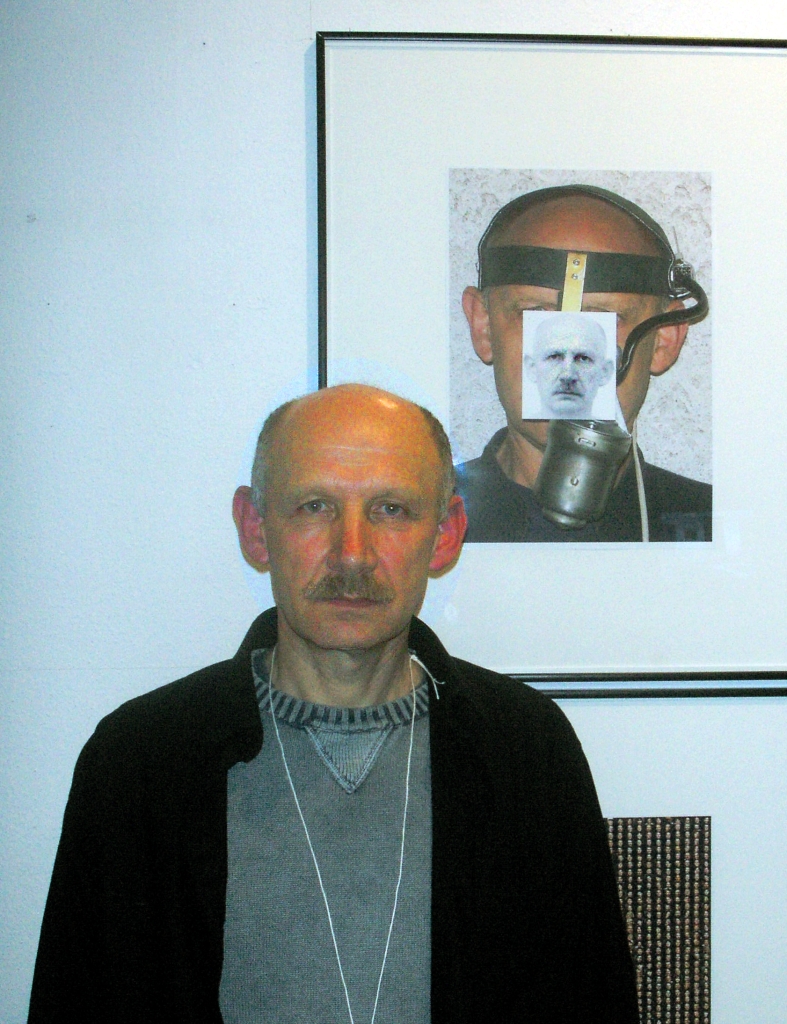
Antoni Karwowski, curator of PI – Performance & Intermedia festival
 Officyna gallery – entrance area
Officyna gallery – entrance area
 gallery space – exhibition setup
gallery space – exhibition setup
 gallery – exhibition setup
gallery – exhibition setup
 gallery – exhibition setup
gallery – exhibition setup
 inauguration 20 Oct – Bartosz Wojcik, director of Officyna speaks
inauguration 20 Oct – Bartosz Wojcik, director of Officyna speaks
 at the opening
at the opening
 some selfportrait artists Antoni Karwowski (Szczecin),
some selfportrait artists Antoni Karwowski (Szczecin),
Agricola de Cologne (Germany) & Marlen Karlen (CH)
 inauguration audience
inauguration audience
 inauguration audience
inauguration audience
 Swiss performance artists Valerian Maly and Klara Schillinger
Swiss performance artists Valerian Maly and Klara Schillinger
 festival gallery for video installation
festival gallery for video installation
 inauguratioon audience – at the computers
inauguratioon audience – at the computers
 Officyna – the exhibition installation
Officyna – the exhibition installation
 Officyna – the exhibition installation
Officyna – the exhibition installation
 Officyna – the exhibition installation
Officyna – the exhibition installation
 Officyna – the exhibition installation
Officyna – the exhibition installation
 Marlen Karlen, Swiss artist who came especially for the opening to Szczecin
Marlen Karlen, Swiss artist who came especially for the opening to Szczecin
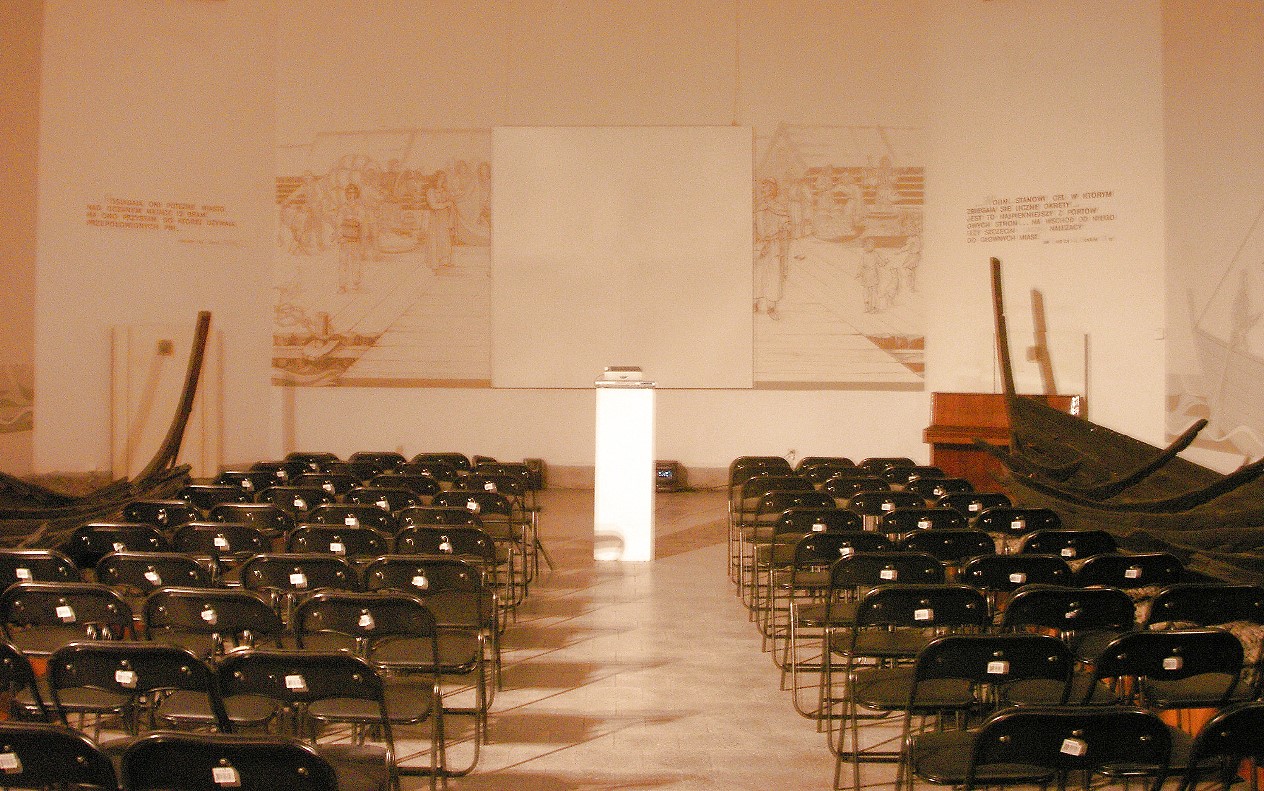 National Museum – screening space
National Museum – screening space


performance Klara Schillinger
 performance Andrzej Pawelczyk
performance Andrzej Pawelczyk
 Polish performance “Chips for Peace”
Polish performance “Chips for Peace”
 German peformance artist – Christian Schmidt-Chemnitzer
German peformance artist – Christian Schmidt-Chemnitzer
 German performance artist Cap Grundheber
German performance artist Cap Grundheber
 National Museum – Cap Grundheber’s performance
National Museum – Cap Grundheber’s performance
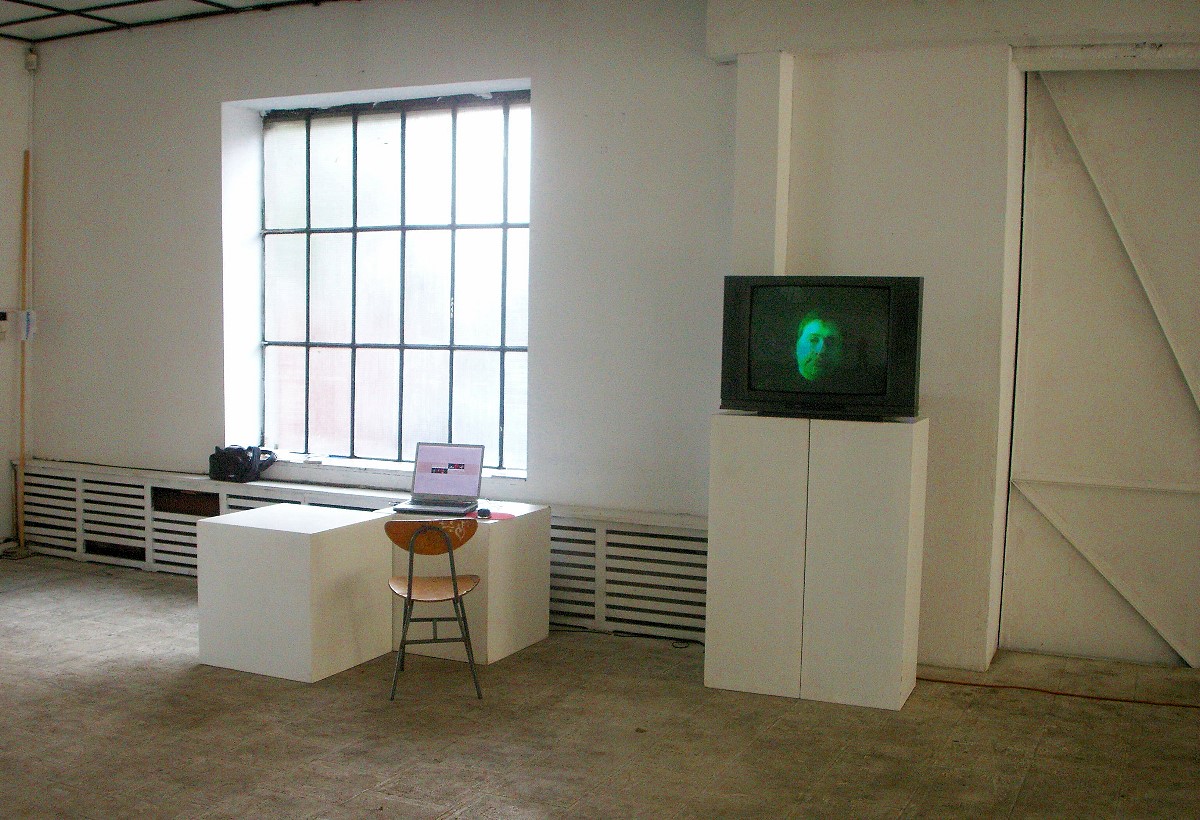
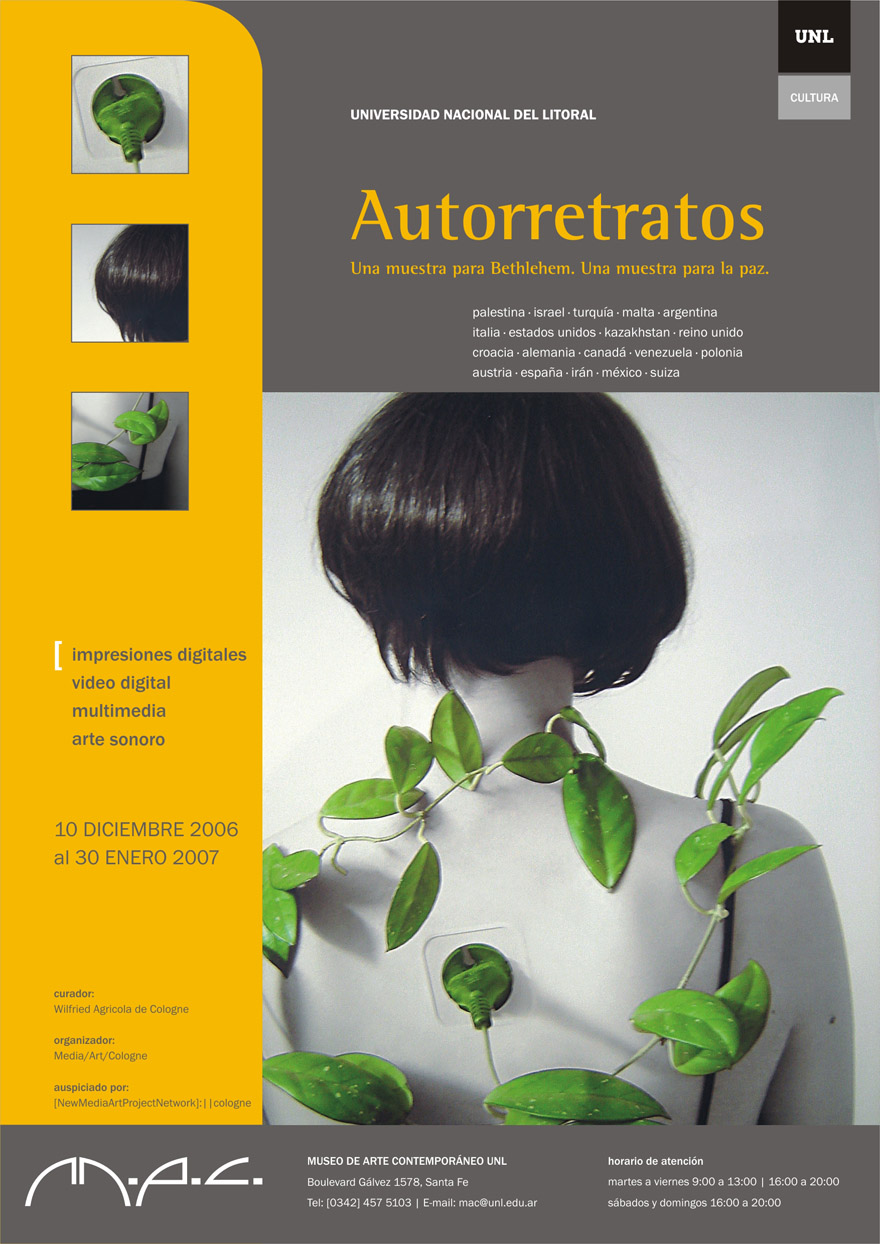
On 10 December 2006, ://selfportrait – a show for Bethlehem – a show for Peace had been opened at MAC – Museo de Arte Contemporaneo Santa Fe/Argentina as the first of a series of venues in Argentina 2006/2007, duration until 28 January 2007.
—-> poster –> download as PDF
—-> banner
—-> invitation cards
MAC – Museo Arte Contemporaneo Santa Fe/Argentina
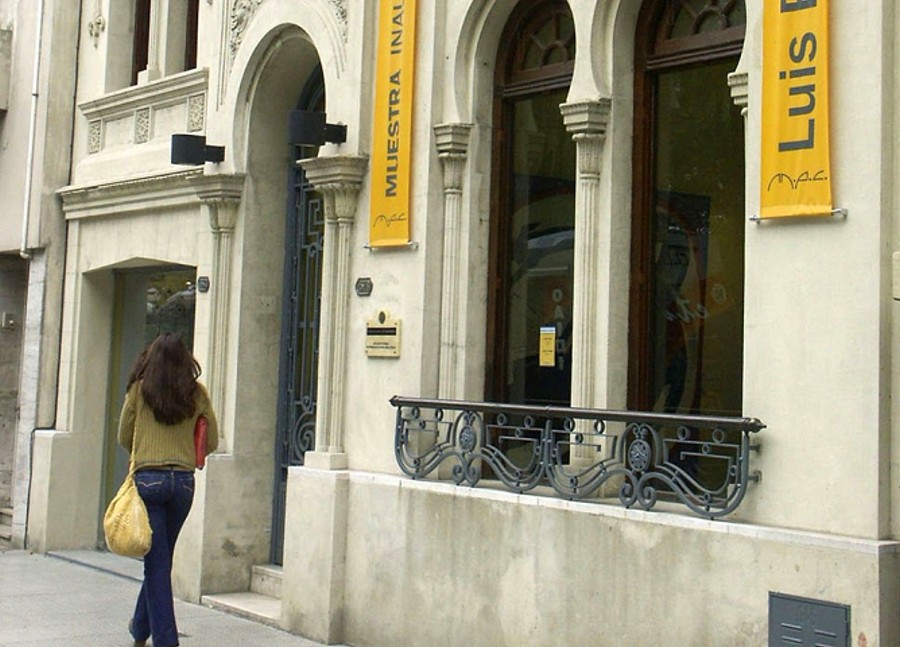
Read the review by Irene Coremberg (Buenos Aires), who visited the show in Santa Fe. Find further the images documenting the exhibition installation at MAC – Museo de Arte Contemporaneo Santa Fe/Argentina). The show opened at December 10 of 2006 at “Museo de Arte Contemporáneo de la Ciudad de Santa Fe” – Argentina – (Bv. Pellegrini 1578).
 Santa Fe is the capital city of Santa Fe province in Argentina. It is located at center – east of Republic, at the margins of Paraná River, which is a long river, colored like the mud, and crosses the province from north to south under a sky in warm colours, always changing.
Santa Fe is the capital city of Santa Fe province in Argentina. It is located at center – east of Republic, at the margins of Paraná River, which is a long river, colored like the mud, and crosses the province from north to south under a sky in warm colours, always changing.
 Very close from river and from city port, at the center of the city, in middle of a long boulevard with great trees, is located the Museo de Arte Contemporáneo de Santa Fe (MAC). Its building shows a colonial style.
Very close from river and from city port, at the center of the city, in middle of a long boulevard with great trees, is located the Museo de Arte Contemporáneo de Santa Fe (MAC). Its building shows a colonial style.
At the entrance we can see the museum announcements and those with the invitation to the exhibition “Selfportrait – a show for Bethlehem – a show for peace”


Walking by two contiguous rooms we will find the digital print artworks, and at the third room, the digital videos, soundart, multimedia and artists statements works, all of them running in different digital supports.
The artworks supporting by DVD, are continuously playing (loop), on individual screen monitors. The visitor can access them with earpieces, as a personal experience.
At the same way, it’s possible to access to multimedia support in Cdrom, as an interactive experience and make a review of all the artworks.




There, also we will find the digital versions of the prints and video; besides, there’s a commentary of each author about his work.
As it is a show conformed by artworks that live in despite of their support, as ideas that live with independence of the physical support of the brain, we can appreciate the same works in a variety of formats at the same time; besides it is a show that runs simultaneously with the same shows in other cities of the word; then, it may be a metaphor of nets where the gift of the ubiquity, the non-material and non-original are some of the most outstanding characteristics.
A Show for Peace. This is a show that overcame the walls of Bethlehem, but also it overcomes the continent walls, and I hope it overcame also the walls in ourselves, waking up our conscious.




I can’t avoid remembering the history of another wall, close to that place at the same province. Around the big cities, as a result of the inequality, in our country grew up “belts” of poverty, where live persons who were excluded from system after years of applying political procedures recommended by international institutions, which were creditors of our country.
At times of a world championship of football, developed here under a military dictatorship, long walls were made in order to hide the poverty from the eyes of tourists who had to come here. At nights, the settlers took the bricks to improve their precarious homes.
Here below, a commentary about some works that impacted me more.
 Among digital prints, Anahí Cáceres speak us about the spirit of these times:
Among digital prints, Anahí Cáceres speak us about the spirit of these times:
We don’t know what is beyond the image, the personage sails towards a space out of the visible picture, towards an uncertain space of future, but with a slight sign of hope.
An abyss? A firm ground? This not the classic representation of a future up, behind a horizon, it looks more like a fall, or a descent. It’s a good idea to read also her message at the multimedia version.
 Bruce Eves shows here a strong and critical picture, with a multiplicity of possible meanings leaving in it.
Bruce Eves shows here a strong and critical picture, with a multiplicity of possible meanings leaving in it.Following my personal vision, in this picture from Wolf Nkole Helzle the whole humanity is present composing the figure of the symbolic human being, the millions of fragments build the symbol of the individual when we move us far away, and the symbolic individual fragments itself again when we approach to the picture.
 It’s a static print image but interactive at the same time. I hope it will be possible to appreciate the experience here below:
It’s a static print image but interactive at the same time. I hope it will be possible to appreciate the experience here below:
 In the artwork of Jasenka Vukelic we find a concept that is related in a point with the previous work:
In the artwork of Jasenka Vukelic we find a concept that is related in a point with the previous work: At this image, there is only one real eye, which looks us through hundreds of representations of eyes in photographs. Looking at the multimedia version, she will tell that God is present through different languages, countries and derivative religions from the same original.
At this image, there is only one real eye, which looks us through hundreds of representations of eyes in photographs. Looking at the multimedia version, she will tell that God is present through different languages, countries and derivative religions from the same original.
In this strong energetic image proposed by Pier Giorgio De Pinto, I can perceive the forces of conflict that reign in the world.
 Among digital video, I find this from Eileen Bonner. The idea that was born in me, after seeing this self-portrait in video, is the dissociation of the vision of oneself, is the capability present in the look of to see from our interior to outwards, and also to fleeing out of the prison of our body and seeing the world from outside, including ourselves in this outside. Obviously, interpretations possible are unlimited.
Among digital video, I find this from Eileen Bonner. The idea that was born in me, after seeing this self-portrait in video, is the dissociation of the vision of oneself, is the capability present in the look of to see from our interior to outwards, and also to fleeing out of the prison of our body and seeing the world from outside, including ourselves in this outside. Obviously, interpretations possible are unlimited.
 In this silent self-portrait of Sofia v. Bustorff, I find the proposal of a subtle trip towards the interior of mind locating ourselves between two worlds: perhaps a way towards change, to future, from the intimacy of ourselves. The images are accompanied only by subtle and rhythmic sounds that remember me the wind, like far machines which make me imagine nets of neurons, or perhaps the weavings of reality, working as cogwheels.
In this silent self-portrait of Sofia v. Bustorff, I find the proposal of a subtle trip towards the interior of mind locating ourselves between two worlds: perhaps a way towards change, to future, from the intimacy of ourselves. The images are accompanied only by subtle and rhythmic sounds that remember me the wind, like far machines which make me imagine nets of neurons, or perhaps the weavings of reality, working as cogwheels.
Of course, the exhibition is very rich and extended, there are much more good artworks to see, and each work and the whole exhibition will result in a different meaning for each one.
I suggest going and seeing it, and try to communicate with the particular universe of each artwork, and to perceive the multiplicity of hidden meanings that live in them, and the new ones that are being born continuously from our interaction with them.
It will be open in Santa Fe until January 30 of 2007.
Irene Coremberg




La imaginación y sus complejas intenciones
por Stella Arber, directora MAC Santa Fe/Ar
Todas las personas tenemos experiencia directa de lo que significa evocar una imagen.
Podemos representar mentalmente a voluntad, un lugar donde hemos pasado un grato momento e incluso disfrutar de nuevo con solo recordarlo. Imaginar, es en buena parte, reproducir mediante recuerdos, nuestra sensaciones, sentimientos, emociones y pensamientos. La imaginación puede permitirnos vivir en el pasado, pero también anticipar aconteceres, podríamos decir que la imaginación es el punto de partida de algunos proyectos y el apoyo insustituible de la planificación previsora.
Si aplicamos lo dicho al género del autorretrato podemos inferir, que a través de la imaginación, el artista puede verse, buscarse, conocerse, mostrarse, exponerse desde una mirada propia y en ella, activar los mecanismos de la representación visual.
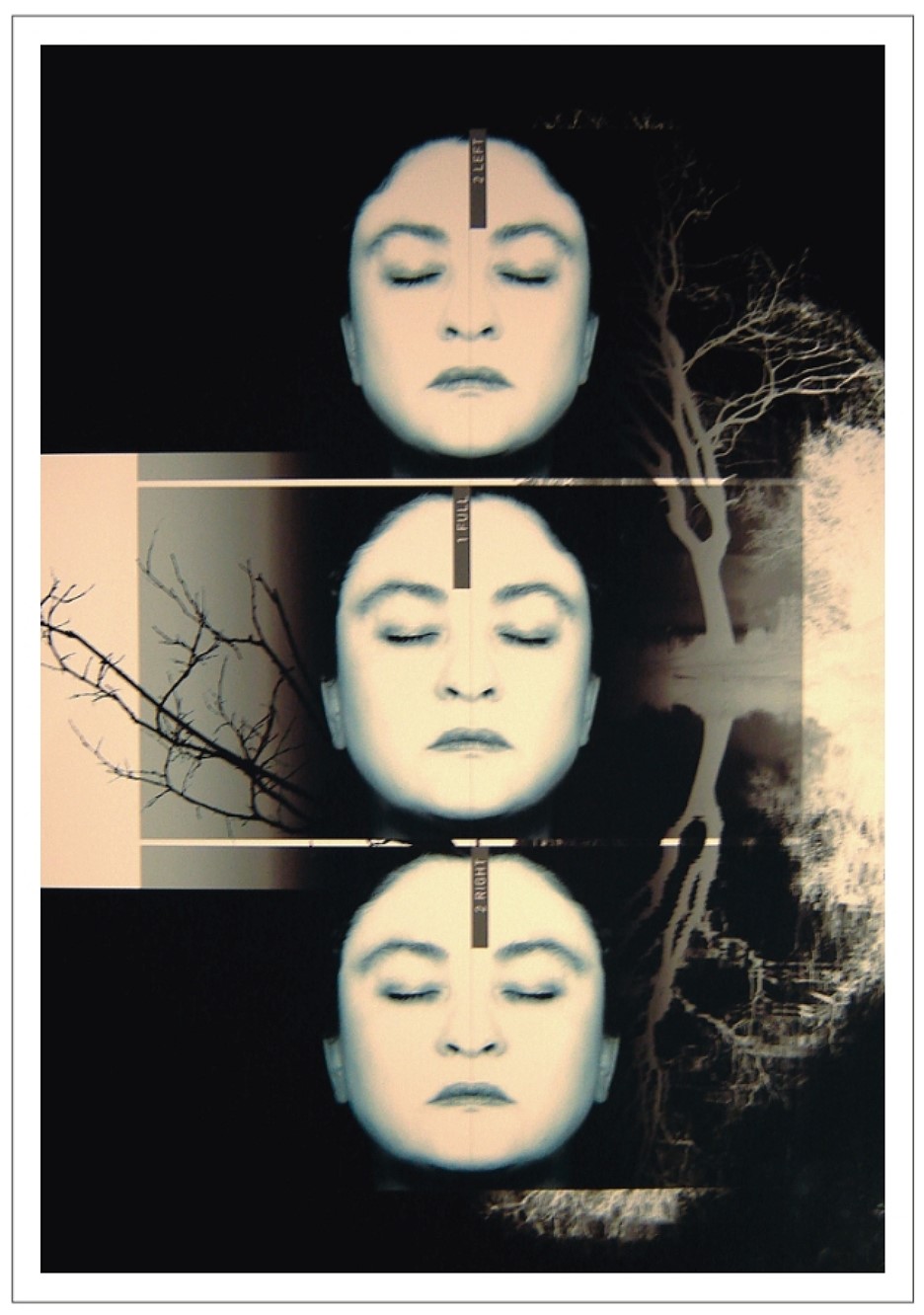
Probablemente quien decide autorretratarse, proyecta el hecho y ancla en si mismo, complejas intenciones que son implicadas en la generación de esa imagen. Cuando alguien se autorretrata, está recuperando una amplia gama de impresiones que tiene de si mismo y debe hacer varios ejercicios de imaginación para equilibrar lo que proyecta y construye mentalmente con el resultado de la imagen lograda, instalando así, el otro representado.
Autorretratarse es recuperar y hacer explicita la información propia almacenada, para luego y en forma implícita dejarla en la imagen, para ello deberá pasar por varias simulaciones mentales de registros físicos reales, construyendo así la trayectoria del proceso de realización de la obra.
El artista se observa a si mismo, con el ojo y con la mente, asociando y a la vez disociando la mirada integral que tiene de su yo, pasando por multitud de hechos primarios, garantizados desde un constructo psicológico que da como resultados “informes introspectivos únicos” de su propia historia, informes que suelen determinar “sesgos” subyacentes en la obra. Es probable además, que muchos de los procesos responsables de imágenes finales, sean inaccesibles también, a la conciencia y ala introspección del propio autor.
En consecuencia el autorretrato es un ejercicio de imaginación profunda, es un proceso de múltiples variables y conocimientos, es una forma asombrosa de organizar la información almacenada y es en definitiva la recuperación de la propia existencia.


Museo de Arte Contemporáneo (Museum of Contemporary Art) –
Universidad Nacional del Litoral
The M.A.C starts up in the Universidad Nacional del Litoral because of the great amount of works of art accumulated during its 80 years. It had not been an appropriate record of that works and it was necessary to protect and safeguard them since they constituted a solid patrimony.
That is why in February 2000 a project is presented and it is started an inventory of the works of art that were already patrimony of the U.N.L (Universidad Nacional del Litoral). A resolution of the Consejo Superior approved the creation of the Museo de Arte Contemporáneo dated July 27th and it was formally and publicly inaugurated on December 4th, 2000; at which time the museum had 93 works of art in its patrimony.
The M.A.C was born as the only space in its gender, accompanying the cultural activity of our city and promoting its own activities. During its first stage, an administrative headquarter and a storage for the works of art is settled in the building of the Foro Cultural Universitario and the Dirección de Cultura de la Universidad. The first M.A.C’s exposition galleries were carried out in different schools and other buildings of the University.
.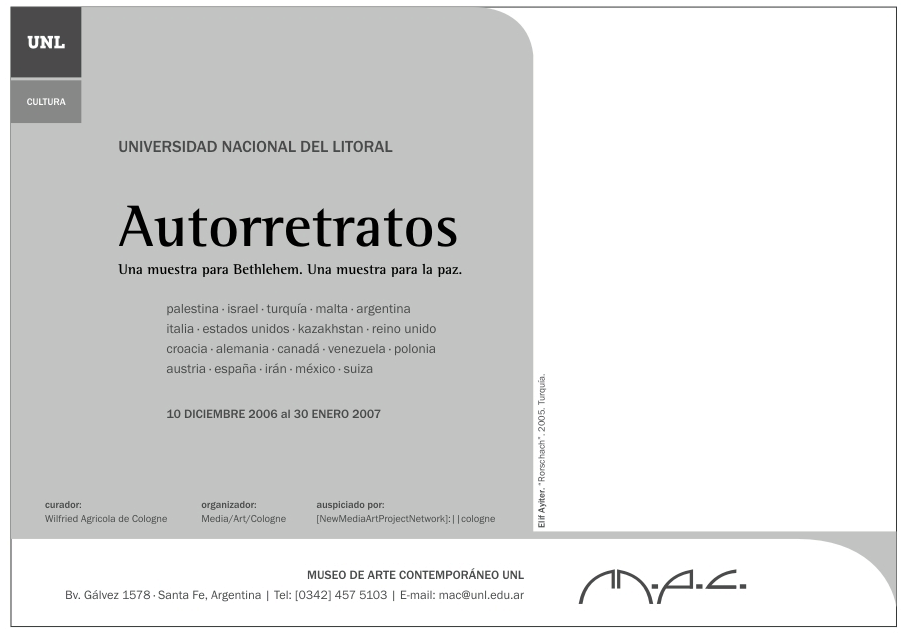
The headquarter of the M.A.C was inaugurated on April 23rd, 2004 along with the Luis Felipe Noé’s showing “Figuraciones y Fulguraciones”. The M.A.C’s building was donated to the University on March 18th, 2003 by a private institution. The building restoration works lasted nearly a year.
By the time of inauguration, the M.A.C had a patrimony of more than 300 works of art form artists of our region, our country and also of foreign countries. Nowadays, the M.A.C has more than 450 works of art in its patrimony. This increase is due to the generosity of the artists that accompanied the labour and the enrichment of the M.A.C’s patrimony by means of their donations.
The works of art that constitute the M.A.C’s patrimony are prints that belong to a urban area which embraces social, cultural and historic values; they are registers of our own memory that we should protect. Although most of this patrimony is intangible and most of its authors are not among us any more, we have their works of art which are tangible and represent us.
Likewise, we also want to express all the generating strength that we have always promoted, making this museum a place that embraces the complexity of the socio-cultural construction, with a broad look, functioning as a dynamic stimulus capable of realizing the present artistic dimension.
Since the creation of M.A.C, and in these five-year-activity, we aim to open a new museum space, in a context that gives it sense, that consolidate the link with the community: its legitimate heiress.
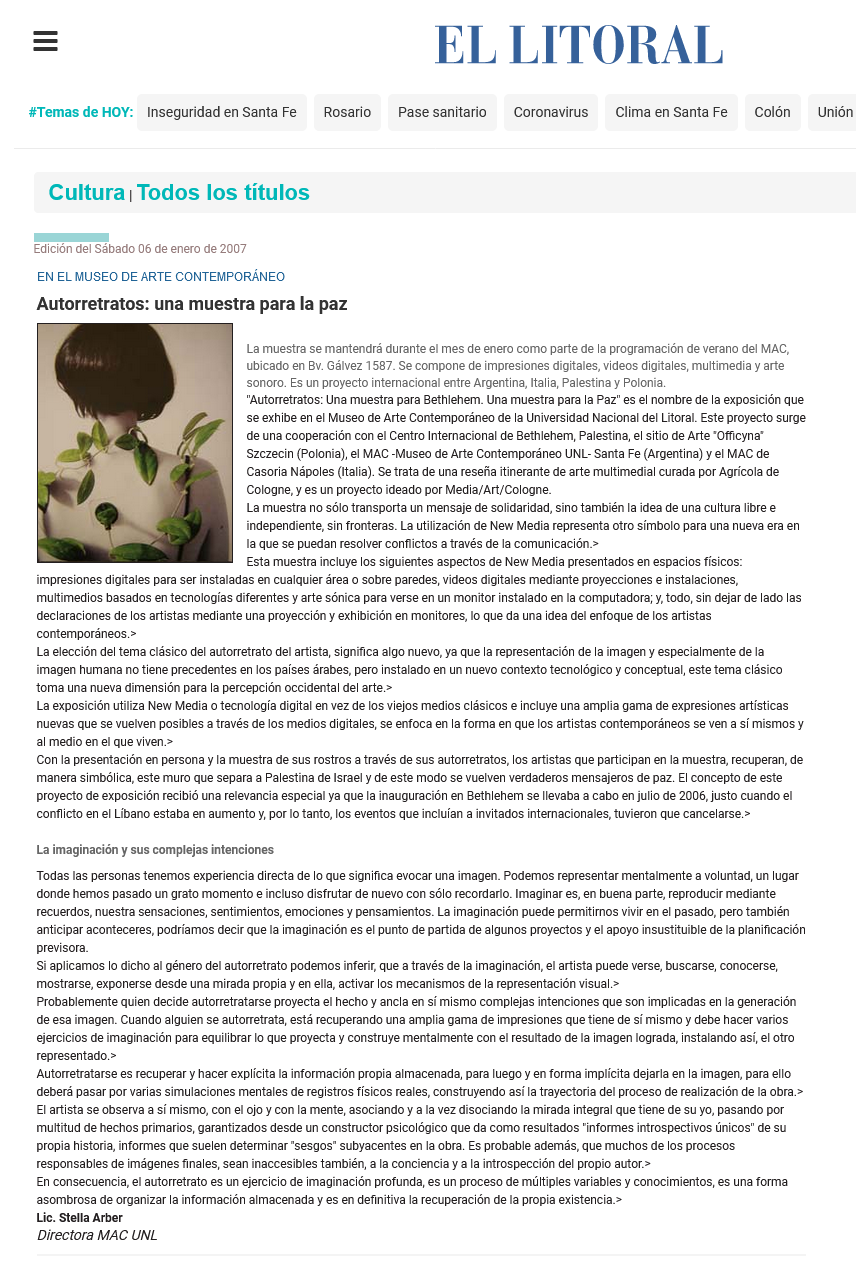
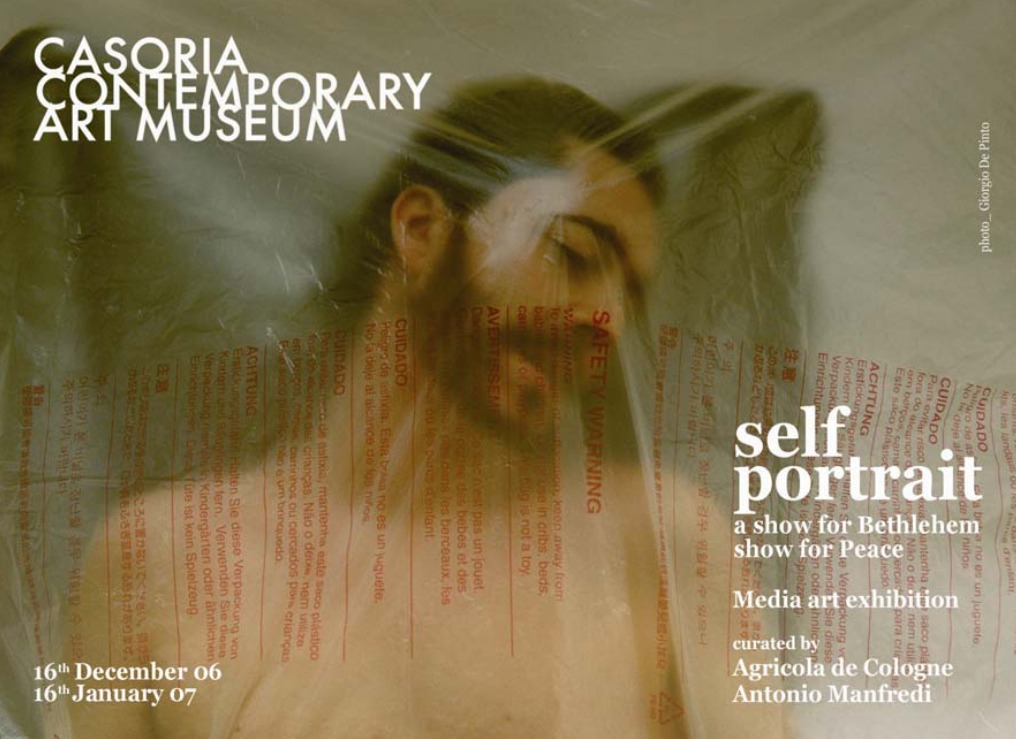
Casoria – Contemporary Art Museum

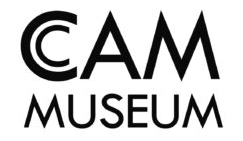

Text: review by Wilfried Agricola de Cologne
Those people who are thinking Naples would be just a nice place based on an exciting long history, has to learn the city has also an ugly industrial side and Casoria represents such an ugly suburb, which is out of function as industrial site, and in this way it represents also a place of social conflicts. In fact, the only nice thing is the view on volcano Vesuv from distance, if it is visble. December is also not really a nice time for travelling in Italy, but visiting Casoria when the weather is just cold and grey, belongs rather to the most unattractive things one can imagine. Normally a visitor finds his way to Casoria only if there is a necessity to do so, but there is no infrastructure and no tourist would ever get the idea to turn from the vivid and magnificent city center of Naples to this former industrial suburb where the garbage is lying meters high along the streets.

If Szczecin in Poland can be seen as a symbol for Peace due to its World War II history, one can call Casoria another type of symbol due to its industrial history and its social focus nowadays.
While looking for the museum on location, the visitor however is surprised to find this museum not located at a former industrial site, but at the underground down of the building which looks much more like a museum than a secondary school, whereby the entrance has to be explored first before it can be found at the backside of the secondary school.
The museum is very young of age, actually once a private initiative is currently obviously acting under the umbrella of the Cultural Department of the municpality of Casoria.

The visitor who wants to enter has to climb the stairs down to the underground first, before then a huge and most impressive space opens which is hosting the permanent museum collection.
The paintings, drawings and installations exhibited there are from their kind and quality not different than in any other museum of contempotrary art, but the artworks were not made by famous artists as they can be found in any other art museum around the globe, but artists from the Naples region and international artists, basically friends of the director. All these smaller and bigger works are nothing else than donations, and this is really impressive again, that the entire huge collection is consisting exclusively of donations, and this seems to be also a main conceptual aspect.
There is also a section for temporary exhibitions, and this represented also the space were the selfportrait exhibition was supposed to be installed. But this space offered for the exhibition did not fit to my idea for a media art exhibition, and a new much bigger space had to be found.
Installing the show was a challenge in so far, as the phyiscal components, i.e. the digital prints were planned to be prepared on location in Naples, as they were supposed to be donated to the museum. This was really not such a fortunate agreement.

Producing prints of museum quality was under the given local conditions anything else than easy, and when they were finalized one day before the exhibition should take place, the director expressed special ideas for the installation, as he wanted each print to be extended through a kind of metal frame on the back for a special hanging with a certain distance from the wall.
All this took so much time during all the night, that only on the very day when the opening was supposed to take place on 16 December, all the more than 50 prints could be hanged on the walls. Also the computers were ready also only a few hours before the opening and from the two projectors which were supposed to run the two programs of videos, one was defect, and the video monitors were not available, at all.
Who had expected an opening ceremory which would be appropriate to the status and aims of the exhibition, where the director was speaking and the curator of the show would have spoken an introduction how to deal with media art in general and in partcular in the case of this exhibition, who had expected a ceremony where the exhibition was given as a donation to the museum as an offical act, this person, in first place it was me, was extraordinary disappointed, because Antonio Manfredi had not planned such a ceremony and I was not informed about this course of events.
Even if the installation was the best what was possible under the given circumstances, in fact the final result was acceptable and I liked it (see also the images), however, the way how the museum and its director were dealing with this exhibition and its donation to the museum, does not belong to what I would have wanted for the show, the artists and finally also the audience.
Especially the fact that the exhibition is based on communicating technology, the lack of communicating stood in contrary to what could be expected.
This was really a strange opening of an exhibition at a strange place somewhere on an alien planet.

The images (see further ahead) give more an objective view on the exhibition than I am able to express myself in words.
From the beginning of the plannings, I warned the participating artists in the exhibition, that the realisation of this show in general, but also at Casoria would belong rather to the category “experiment”, it really did, but retrospectively seen, I am not sure whether this experiment was successful.
While I am not happy as the curator and creator the show, the participating artists have certainly no reason to complain, as from an aesthetic point of view the show was finally well installed, and that’s also what the visitors could perceive. Further I was informed that the incomplete video equipment was immediately after the opening properly and completely installed, and this represents the most important finally.
I received some good feedback from the show, and I also think it represents certainly a good thing to bring new ideas of contemporary art to such a cultural desert as Casoria represents.
Wilfried Agricola de Cologne
January 2007

About CAM


CAM_Casoria Contemporary Art Museum was born in 2005 with the aim to become a cultural pole, an experimental laboratory but, above all, as a point of reference for universal contemporary art with an open context.
Founded and directed by Antonio Manfredi, starts from the general consideration that a public collection of art is mirror of the times art and culture. Therefore the attention of the museum team is focused on a fundamental aim: the Museum to be a cultural reference point, stimulating for everybody and not at all a static place. The Museum means therefore to be a place of meeting and exchange, with wide and several cultural programs addressed to the visitors.

CAM_Casoria Contemporary Art Museum was not born as mere cultural exhibition machine, not even as museum containing simulacra, but it is close to how we would like a museum to be today: a place where culture and research is produced, where didactics is carried, stimulating an hermeneutic experience of the contemporary, where creativity is visualized, where the current aesthetic complexity is known and practiced.
The collection of the Museum of Contemporary Art of Casoria is open to an international growth; worldwide artists are in there with no prejudices on regards of any country nor ethnicity.
The main objective is to bring closer and involve all of those interested to contemporary art and sensible to the fast revolution of expressive forms all over the world. Through periodical workshops – where artists are invited and involved – the interaction between artists exposing and visitors is carried so as to make contemporary art clear and comprehensible to all those people willing to open up their own horizons.
It extends on an area of 3.500 sm ca out of which 3.000 sm are permanent exhibition.
It permanently exposes and has acquired in its collection 1000 works ca of contemporary art of painting, sculpture, photography, video and installations by important worldwide artists.
Its multimedia and far east art collection is among the biggest and its collection of contemporary Neapolitan artists (from the second post-war period till today) is among the most complete in Italy.
Among its activities is the promotion, exhibition, cataloguing, collection of works and books on contemporary art.
Travelling exhibitions and events are also carried in cooperation with important overseas Museums of Contemporary Art. Guided tours through its spaces for teachers, pupils and students are also arranged.


On 16 December 2006,
Casoria Contemporary Art Museum Naples/Italy
is inaugurating the media art exhibition
://selfportrait – a show for Bethlehem – a show for Peace.
The show is running until 16 January 2007.
The show at CAM



Directly from Italy, the first pictures from the show at Casoria Contemporary Art Museum Naples are now online, a detailled report follows in sequence—>
http://downloads.nmartproject.net/museo_casoria_press_in_italiano.pdf
Review
://selfportrait exhibition at Casoria Contemporary Art Museum Naples/Italy
16 December 2006 – 16 January 2007
Following images document the museum space and the show–>
the text follows afterwards—>

the location–>
Casoria Contemporary Art Museum

view from outside

view from outside

entrance area

entrance area

museum – space of permanent collections

museum – space of permanent collections

museum – space of permanent collections

museum – space of permanent collections

museum – space of permanent collections

museum – space of permanent collections

museum – space of permanent collections

museum – space of permanent collections

museum – space of permanent collections – installation
.
—>
The show – the exhibition space
—>

poster outside

poster outside

director Antonio Manfredi at work

space in preparation

view on empty exhibition space

computer space – opening

computer space – opening

video projection space

space for the digital prints

Pier Giorgio de Pinto in front of his poster

Pier Giorgio de Pinto & Agricola de Cologne

digital prints 1

digital prints 2

digital prints 3

digital prints 4

digital prints 5

digital prints 6



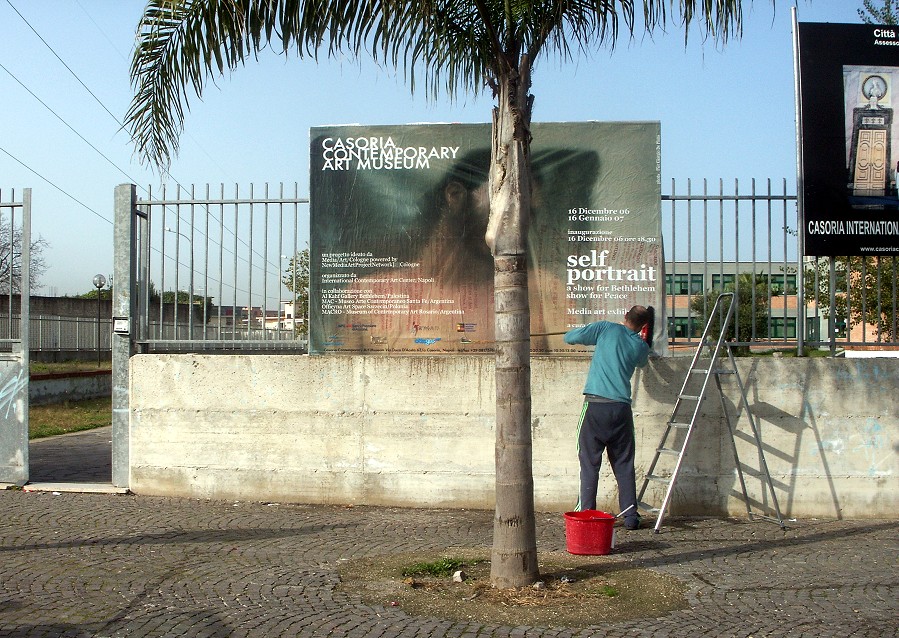
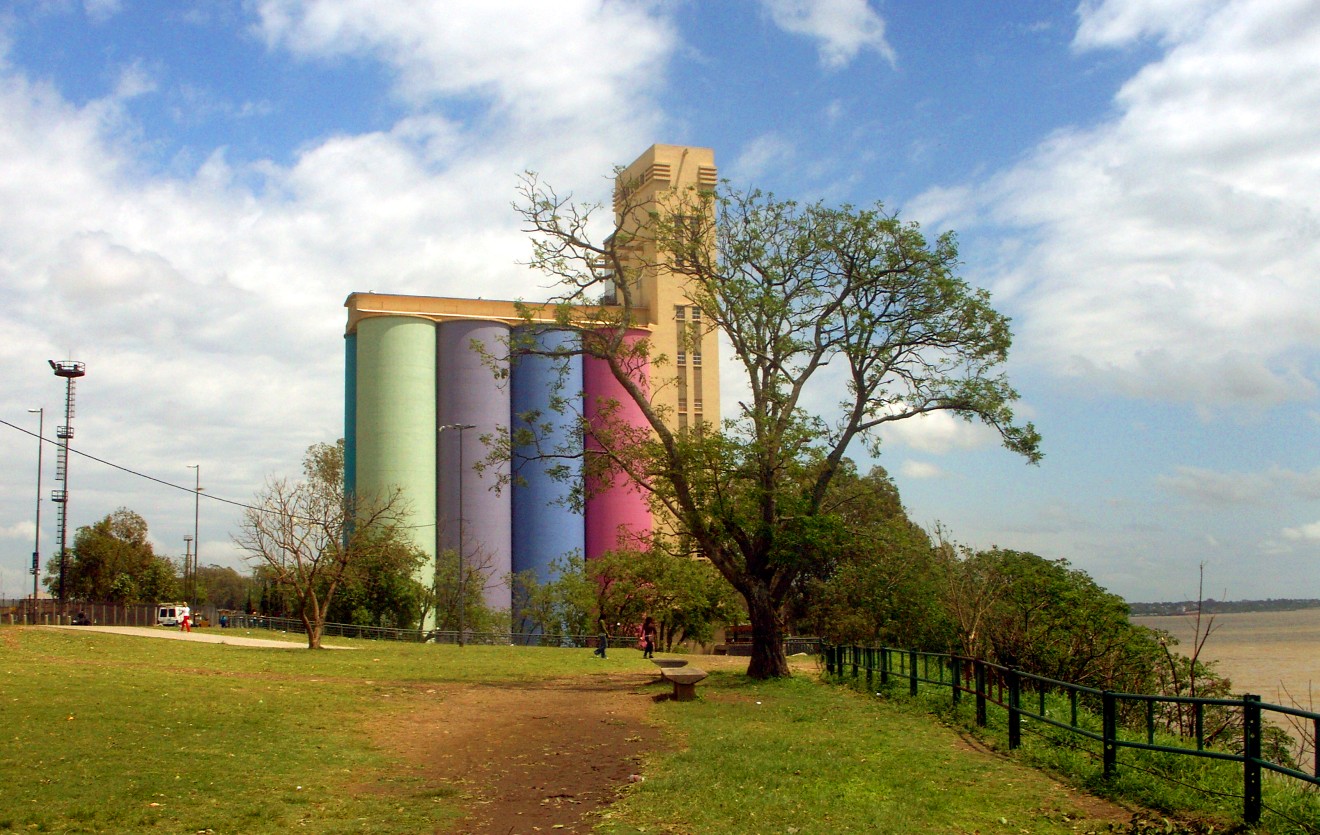
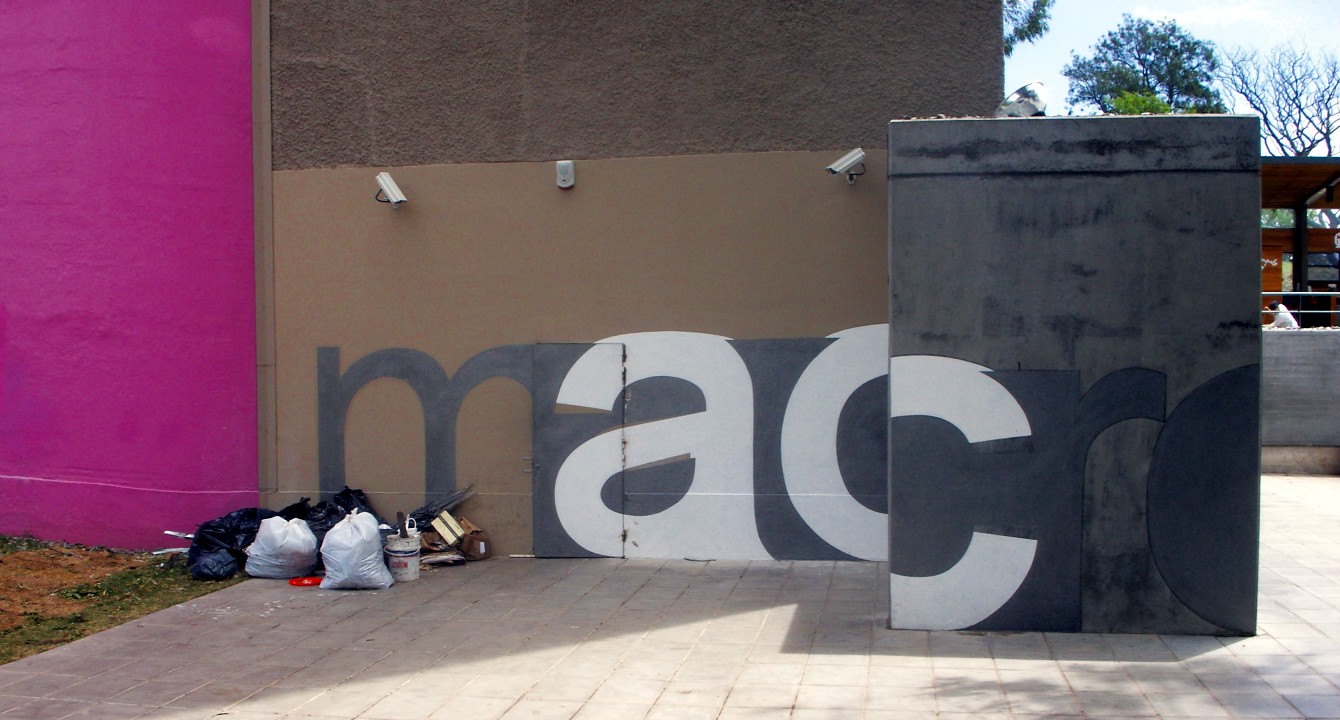
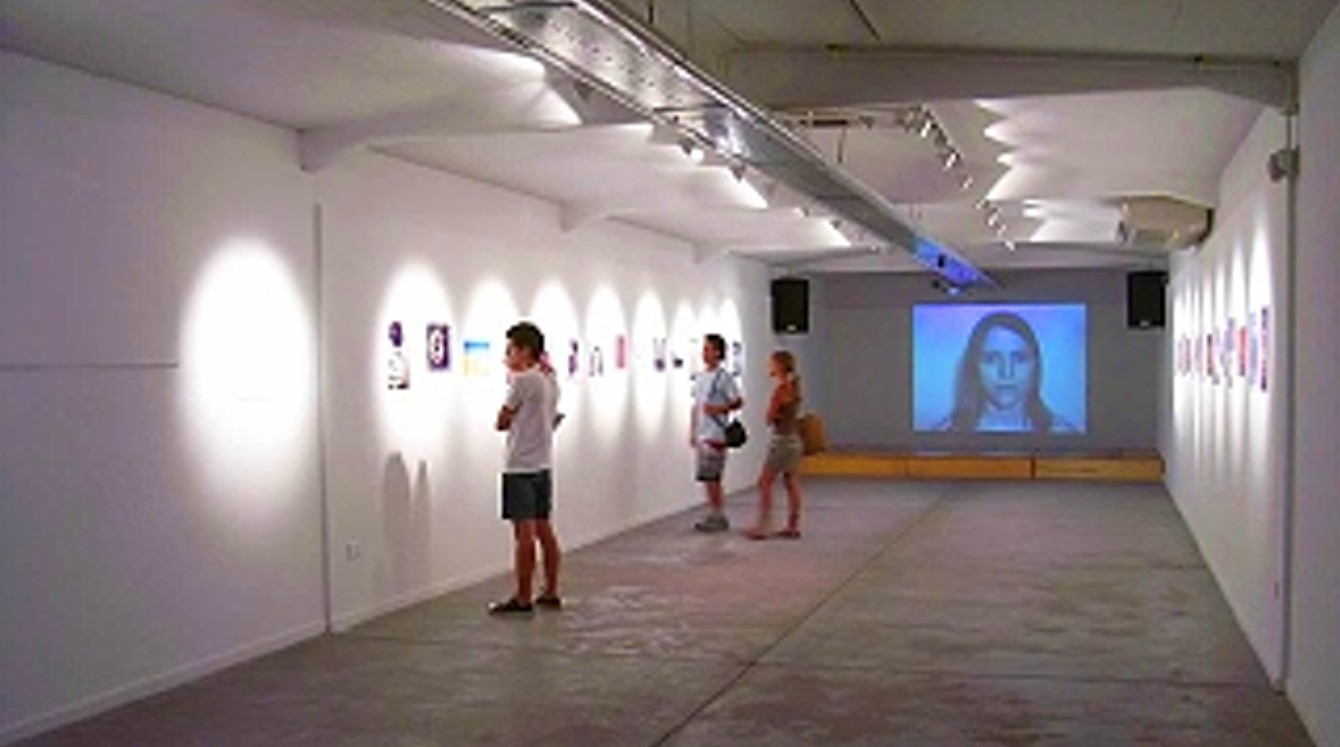
MACRO – Museo de Arte Contemporaneo in Rosario/Argentina will open on 9 February 2007 the media art exhibition ://selfportrait – a show for Bethlehem – a show for Peace.

The show at MACRO – Museo de Arte Contemporaneo Rosario/Argentina was opened on 9 February 2007 and was finalized on 2 March 2007
On 6 March 2007, I received this message from MACRO Rosario:
–>
Agrícola de Cologne:
Es de nuestro agrado informarle que la muestra a sido un éxito, recibió muy buenas criticas por parte del público.
La misma fue visitada por más 1000 personas, que ingresaron al macro en el tiempo que estuvo expuesta (del 09 de febrero al 02 de marzo).
Por medio de este e-mail le hacemos llegar fotos que registran el espacio donde estuvo montada la misma.
Saluda atte
Castagnino+macro
—>
English
Dear Agricola de Cologne,
It is a pleasure for us to inform you about the success of the show, which received very good critics from the visitors. While the exhibition was running (9 February – 2 March 2007) more than 1000 visitors entered the space. Please find attached some photos of the installation of the show.
Greetings from
Castagnino & MACRO
MACRO is a unique art museum installed at a former grain silo situated close to the Parana river. The visitors have a magnificent view on the the city of Rosario and Parana river islands.
On the museum site, a comprehensive description of the exhibition project can be found in Spanish language
http://www.macromuseo.org.ar/archivo
—->
this message was accompanied by a couple of images documenting the show at MACRO
–>








